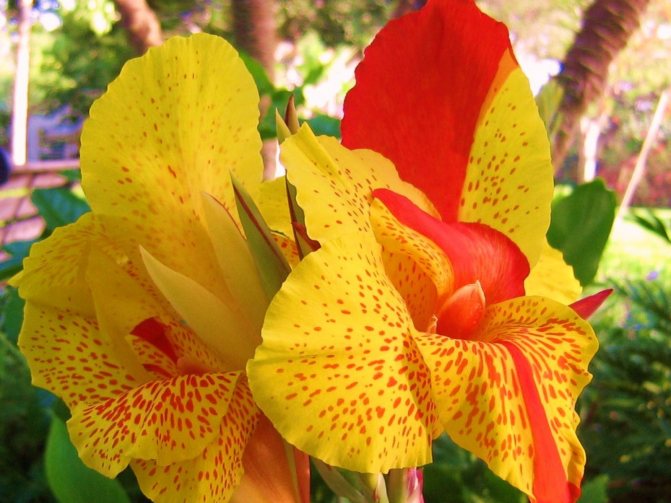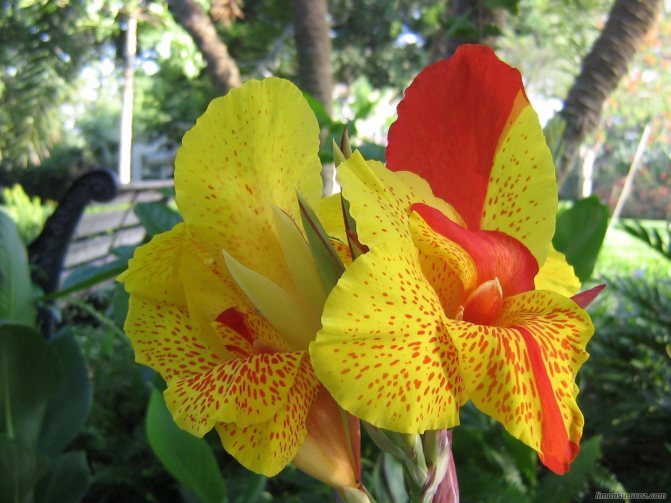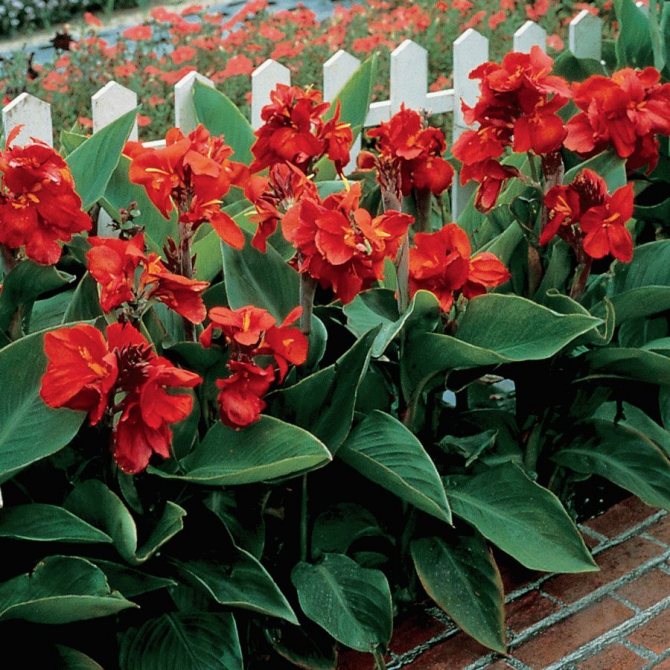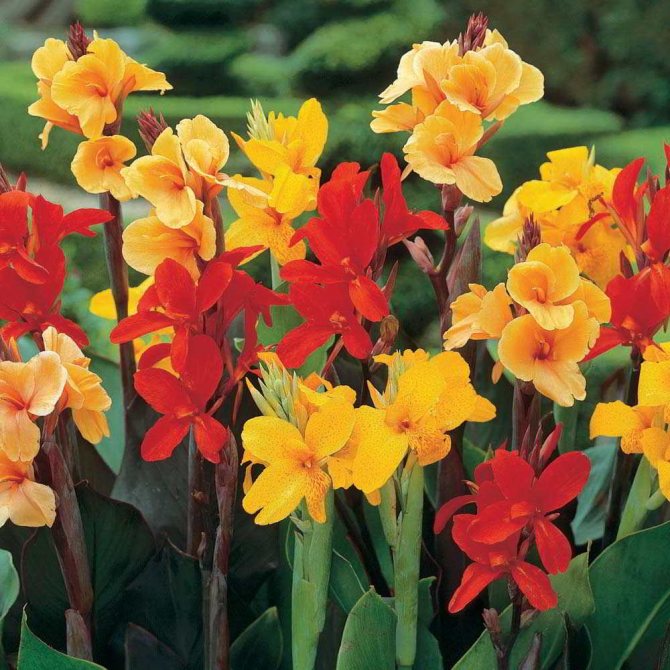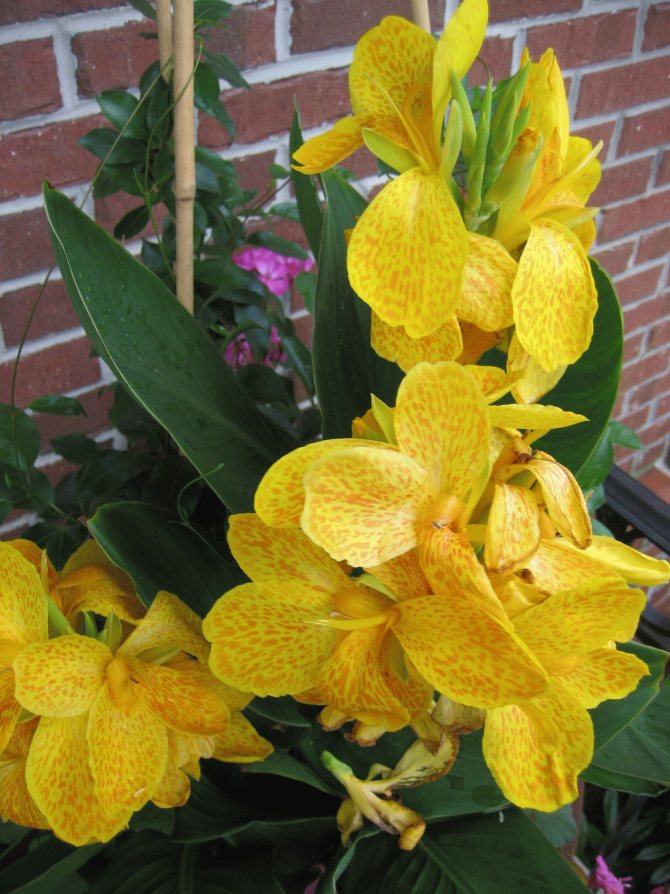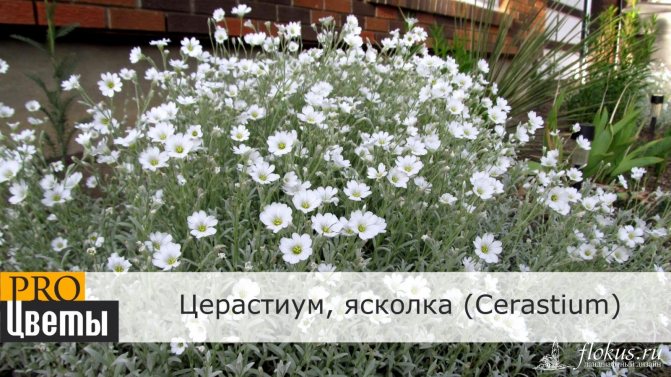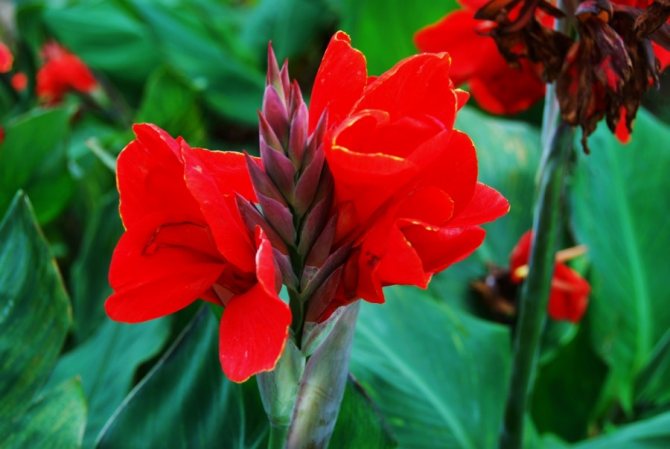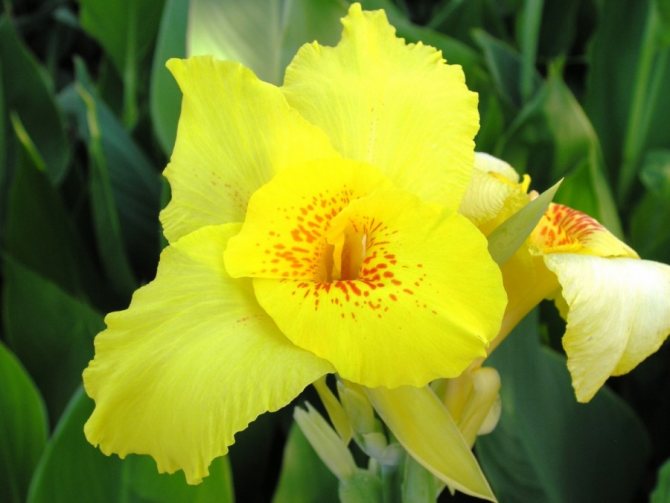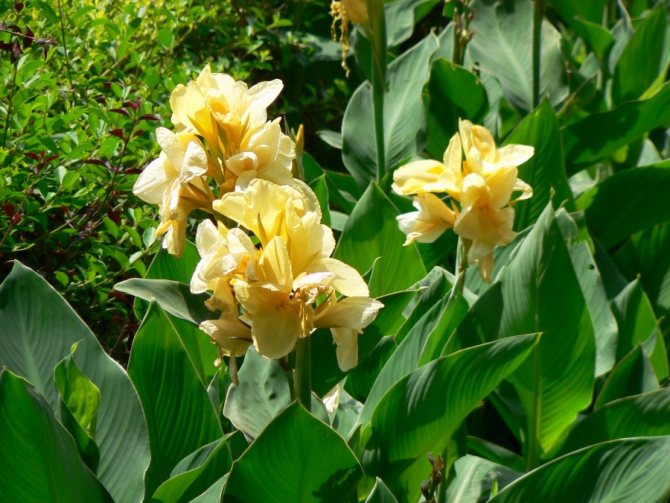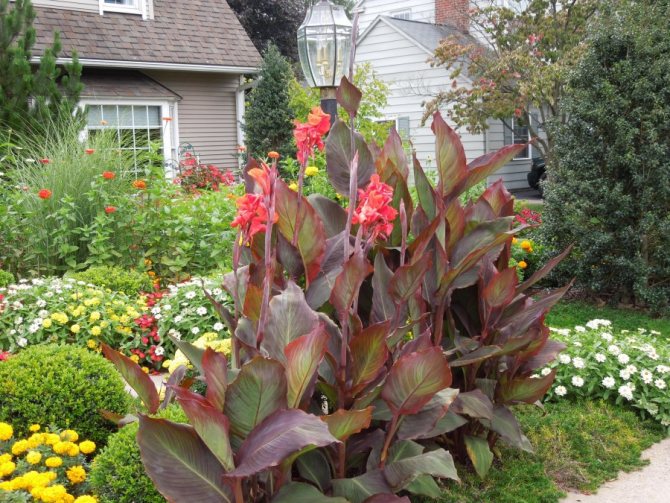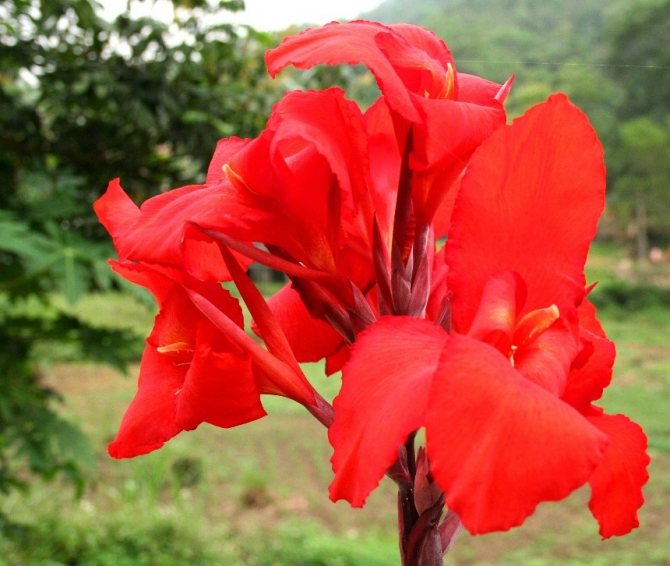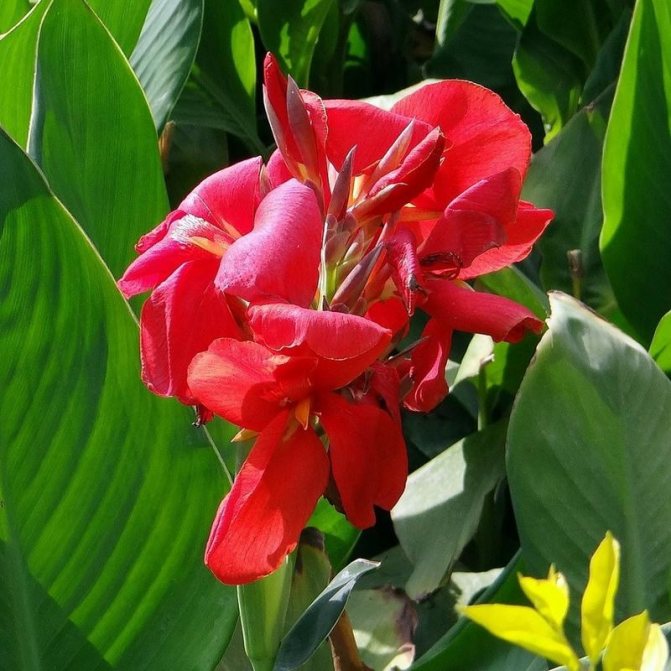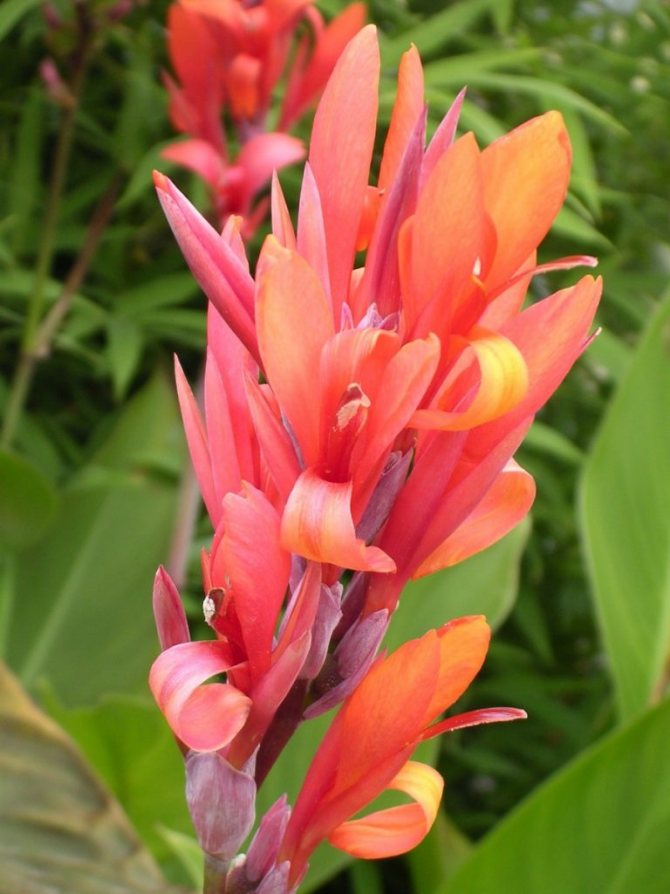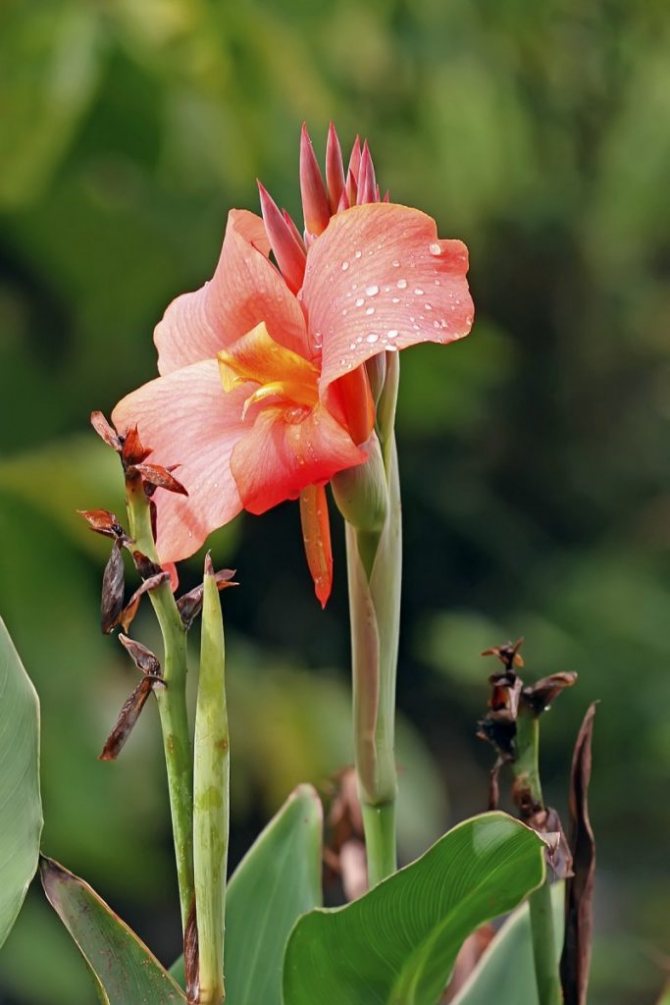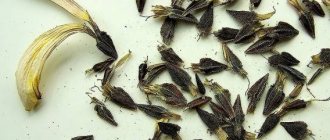Home »Flowers and plants» Flowers »Perennial flowers
Perennial flowers
Olga Polyakova

Canna is a perennial plant that Europeans first became acquainted with in the 16th century. The first specimens of cannes came from South America to Europe thanks to the Portuguese, from which it was concluded that the plant is present only in the New World. The plant has exceptional decorative properties, representing a tall shrub with bright and large flowers and magnificent leaves. For more than three hundred years, beautiful specimens of cannes have adorned the gardens and greenhouses of many flower growers. Planting and caring for cannes in temperate climates today is not a serious problem and can be implemented with a minimum cost, since the plant is relatively picky. The only problem that the florist will face is the plant's thermophilicity, however, it is easily solved by overwintering the plant's rhizomes in more benign conditions.
- Botanical description
- Cannes landing
- General issues
- Planting rhizomes
- Seed planting
- Plant care
- Rhizome storage in winter
- Growing cannes indoors
- Selection of soil and containers
- Care
- Conclusion
Features of cannes garden
Culture has a unique appearance and can be a decoration for any garden plot. Cannes has the following features:
- The roots of the culture are large. They grow not only in depth, but also in width, therefore, when planting, this criterion must be taken into account.
- The stems are tall and can grow up to 3 meters.
- The stems are firm and fleshy.
- The leaves are in the shape of an oblong oval.
- The stems and leaves are highly nutritious and can be used as feed raw materials.
- The inflorescence is large, bisexual, can be red, orange, pink and white.
Flowers can be bicolor, which is popular with modern gardeners. When planting a plant, it must be borne in mind that cannes prefer open areas and a large amount of space.
Photo gallery
Requirements for growing conditions
In order for the plant to please with its flowering, it is necessary to properly observe the care and method of growing the crop.
Illumination
The plant prefers sunny places. With a lack of sun, the plant reduces its development and does not bloom. The crop is not planted near large buildings that can obstruct sunlight. When planting seedlings on windowsills, it is necessary to give preference to the south side.
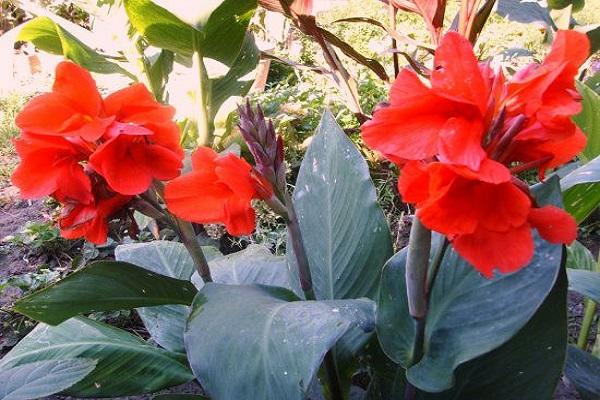

Temperature regime
The plant does not tolerate low temperatures and may die. The flower begins to develop only after the air temperature reaches 22 degrees.
Required soil composition
The flower prefers nutritious soil. In order for the flower to develop well and bloom profusely, it is necessary to mix two parts of the soil with one part of humus, wood ash, peat and sand. Such a composition will accelerate the development of the root and will saturate the plant with the necessary components during the season.
Correct fit
As a resident of warm and humid places, the sunniest area in the garden is chosen for Cannes.
The flower must be reliably sheltered from gusts of wind, otherwise the tall peduncles may break. For especially tall varieties, it will be necessary to install strong stakes for the peduncles.
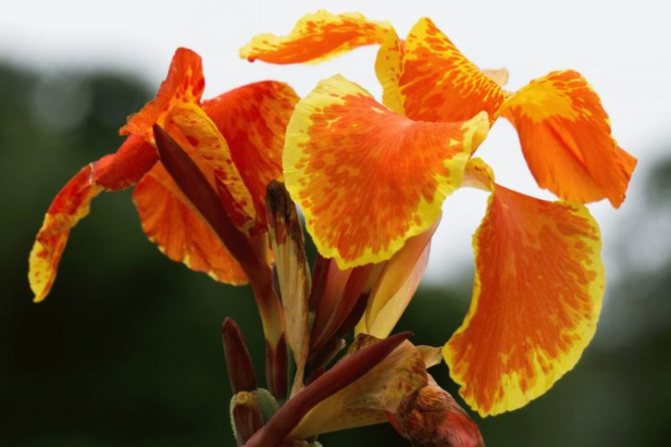

Loose soil, rich in humus, with good moisture capacity is suitable for the plant. It can be fertile loam and even sandy loam, provided there is sufficient moisture. Before planting cannes, at least 5 kg of good fatty humus (not fresh manure!) And about 4 kg of coarse sand are applied to the site. The soil is dug up to a depth of 35 cm, so the plant has a large branched rhizome.
Advice. The flower responds positively to the "warm bed" device when a fresh mullein is applied to the bottom of the planting holes. The manure is spilled with hot water, covered with soil, with a layer of 25 cm, and only then the canna rhizome is planted. Burning manure generates heat, which warms the roots of the flower.
The flower is planted in May, when the threat of frost has passed. The distance between the bushes is maintained at 50 - 90 cm, depending on the size of the variety. The canna rhizome is immersed in the soil by 10 cm.
Growing cannes in the garden
In order for the flower to be grown in the open field and to decorate garden plots, it is necessary to observe the peculiarities of care.
Sowing cannes seeds
In order to use seeds as planting material, you must first perform the following steps:
- Treat the seeds with boiling water and place in a thermos. This will soften the tough shell and speed up the germination process.
- The material is planted in mid-February in a container for seedlings, seedlings appear in 20-25 days.
- After the emergence of seedlings, it is necessary to place the pots in partial shade and a cool place no more than 16 degrees.
Flowers are left in a cool place until they are planted in open ground.
When to plant cannes outdoors
It is necessary to plant flowers in open ground after there is no risk of frost. Planting crops in open ground is carried out on May 6-9, when the ground is completely warmed up. If weather conditions are favorable, planting can be carried out in mid-April, however, such beds are covered with plastic wrap at night.
Planting and caring for cannes outdoors
To get a long and bright flowering, an ornamental crop must be properly cared for throughout the season.
Choosing and preparing a place for growing in the garden
To achieve the most abundant and long-lasting flowering from the garden canna, it is recommended to choose the right site for planting. The growing area should be sunny and well heated. You can not plant a crop in lowlands and in areasexposed to the negative impact of strong gusts of cold north wind. The flower garden must be properly prepared in advance by digging a shovel to the depth of the bayonet and removing all weeds, as well as debris.
The plant prefers areas represented by fertile, rich organic matter and warm soil. The soil is best suited for cultivation, consisting of humus, leafy soil, coarse sand and peat in equal proportions. A prerequisite is a reliable and high-quality drainage device.
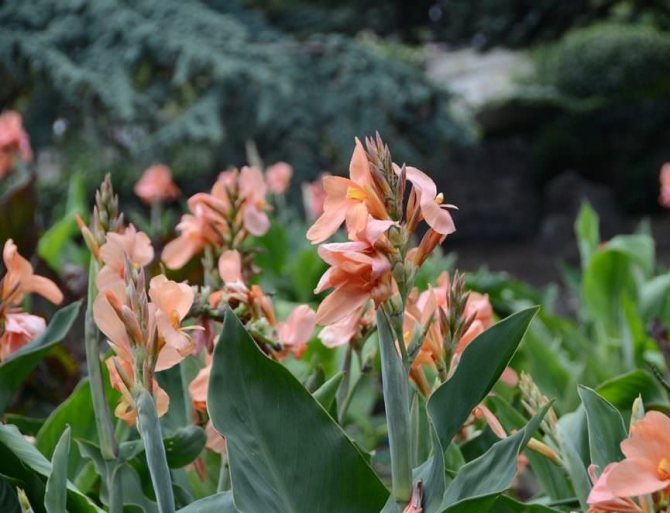

Planting technology and timing
It is advisable to plant a plant in a permanent place in the second half of May, after the risk of a return of spring frosts has passed. Failure to comply with planting dates often becomes the main reason for the lag in the development of the canna or the complete absence of flower formation. It is best to plant the plant on a hot bedding that performed in accordance with the following technology:
- preparation of planting holes with a diameter of about half a meter;
- backfilling of pre-prepared planting pits on the bottom of a 20-cm layer of fresh high-quality manure;
- backfill of nutritious soil substrate 25 cm high;
- high-quality soil moistening in the planting pit with a solution of potassium permanganate;
- placing the rhizome on top of moistened soil with a depth of no more than 6-8 cm and sprinkling it with a nutritious soil substrate.
The standard distance between planted plants and between rows should not be less than half a meter. Flowering occurs about one and a half to two months after planting the planting material in a permanent place in open ground.
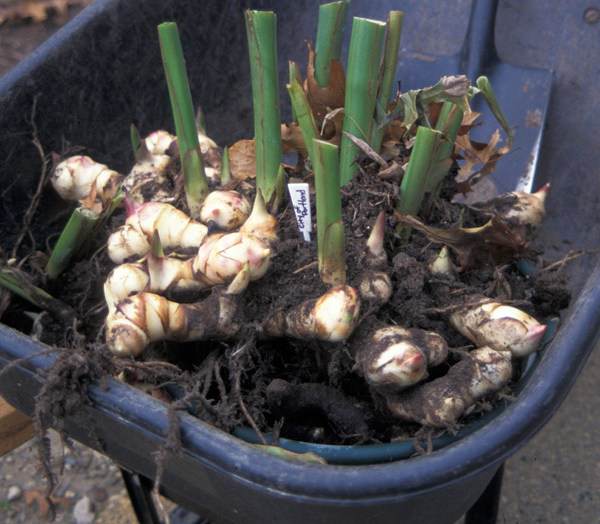

Watering and feeding
Cannes belongs to the category of moisture-loving crops, so it is necessary to provide abundant irrigation measures with warm and soft water. Top dressing is carried out throughout the entire period of growth and development, but at the stage of foliage withering away, watering and feeding should be gradually reduced, and then completely stopped.
Experienced flower growers practice frequent fertilizing watering with complex mineral fertilizers or diluted mullein infusion once a month. The rate of top dressing is 40-50 g of a mixture based on 12 g of nitrogen, 25 g of phosphoric, 10 g of potassium fertilizer for each square meter of the flower garden. Watering should be combined with loosening and weeding activities.
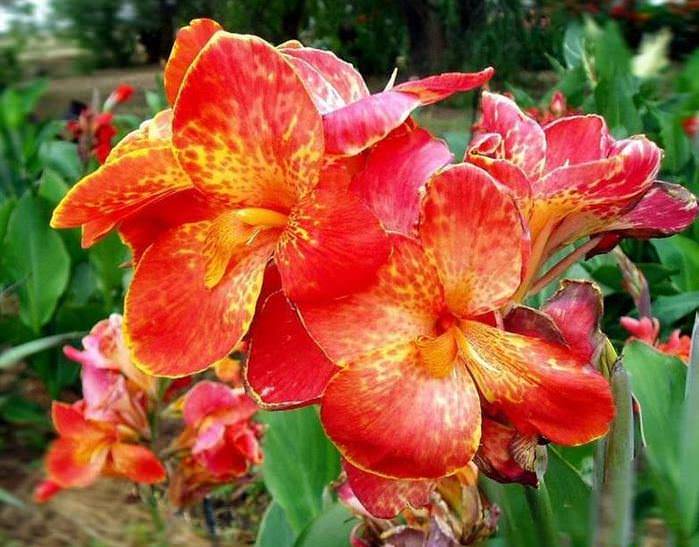

Protection against diseases and pests
Rarely, cannes are affected by bacteriosis, accompanied by blackening and subsequent death of the buds or the appearance of blackening spots on the foliage. A bacterial infection is incurable and is often caused by excess moisture.
Strong waterlogging of the soil also becomes the cause of damage by rust fungus, for the destruction of which special treatments are used or a solution based on potassium permanganate, diluted at the rate of 4.0 g per bucket of warm water. You can spray the plant periodically "Vertimecom" or "Mauritius".
How to store cannes (video)
Why cannes do not bloom, and how to solve the problem
Sometimes, with visible good care, cannes do not bloom. In this case you need to pay attention to care. In home floriculture conditions, the main factors can be represented by the lack of a temperature level necessary for growth and development, as well as improper watering and feeding or uncomfortable air humidity.
Also, plants can be damaged by aphids, scoops, spider mites, rust and mosaics, which weakens the culture and does not allow flowering. In this case, it is necessary to properly balance the care, as well as to carry out the whole range of preventive and therapeutic measures.
Canna after flowering
After the daytime temperatures drop to almost zero, the leaves are cut off, and the flowers are dug out, while preserving an earthen coma around the tuber. After flowering, you can dig out the planting material for winter storage or plant it in flower pots, and then put it at home on a well-lit windowsill. During this period, watering must be reduced to one or two times a month. Top dressing is completely excluded.
How to care for your culture
Caring for cannes requires compliance with some features that will allow you to properly grow a flower healthy.
How to properly water cannes
The plant requires moderate watering, excessive moisture can lead to the formation of pests and diseases. In order to prevent water from accumulating during the planting of flowers in open ground, drainage is used. The plant should be watered every two days in a small amount.
Important. The plant may react negatively to watering with cold water. Therefore, the culture is irrigated with warm water heated in the sun..
Fertilizing and feeding cannes
The appearance of flowers depends on the amount of nutrients in the soil, so feeding is carried out regularly.After transplanting seedlings into open ground, it is recommended to apply nitrogen fertilizers, potassium and phosphorus are used before the formation of inflorescences, such substances increase the duration and abundance of flowering. Organic fertilizers can also be used in the middle of the season. Most often it is humus or bird droppings, which are mixed with water in a 1: 5 ratio.
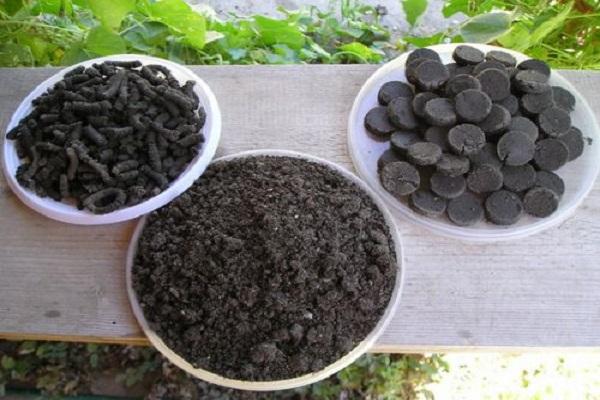

Cannes pruning
In order for the culture to retain its decorative appearance, it is necessary to regularly prune. All faded inflorescences and damaged leaves are removed from the plants. After the culture has completely bloomed, the stems are removed and the flowers are prepared for winter storage.
Botanical description
Despite the monotypic nature of the family (represented by only one genus) and a small number of species, the canna crosses perfectly within the genus. This allows you to get a fairly large number of its varieties and hybrids, which have a variety of external data: from height to shade and shape of flowers.
The origin of the European name for cannes is very mysterious. The word "canna" in ancient Greek means "reed". Perhaps it was obtained due to the slight external similarity of the tall stems of the plant with the stems of sugar cane. However, the similarity of these two completely different species (even belonging to different orders) on the stem ends.
Preparing Cannes for winter
The culture does not tolerate a drop in temperature, so it is necessary to carry out proper harvesting before the onset of frost. In order for the planting material to be preserved throughout the winter:
- From mid-August, the watering regime is reduced to 1 time per week.
- In September, humus is introduced to saturate the roots with the necessary minerals for further storage.
- Bushes will huddle as the temperature begins to drop, which will reduce the risk of damage to the plant.
- At the end of September, the stems are cut at a height of 15 cm from the ground.
See also
Description of varieties of terry hibiscus, planting, cultivation and careRead
It is not recommended to leave the stems, they additionally consume nutrients and lead to depletion of the roots.
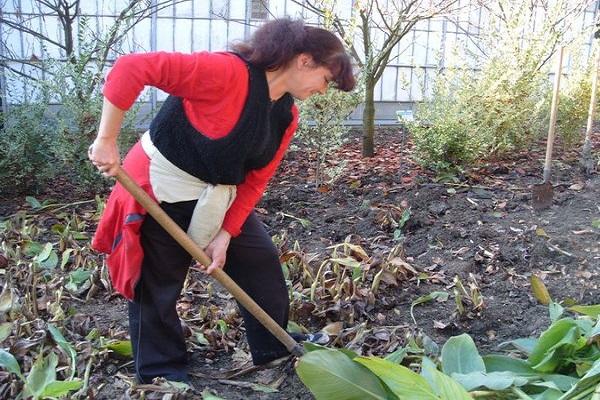

The timing of digging out the bulbs
Digging of canna roots is carried out in the fall before the onset of severe frosts. The period of digging out the roots from the soil depends on the weather conditions. Most often, the procedure is carried out in early October. The plant, together with a lump of earth, is removed from the ground and placed in a previously prepared container.
The necessary conditions
As soon as flower sprouts appear on the soil surface, it is useful to mulch the ground with straw cutting, high peat, and mowed grass. This measure will allow moisture to be better retained in the soil. And he loves "to drink" canna.
Water the plant only with warm water, abundantly, but not allowing the soil to become waterlogged.
Stagnant water at the roots of cannes is especially dangerous, combined with cool weather. Fungal diseases will not keep you waiting. During the flowering period, the need for moisture increases. In autumn, watering is reduced, giving the rhizomes the opportunity to mature.
It is not demanding to the subcortex of the canna, it is enough to water the plant with a solution of fertilizers during the period of filling the buds, and again, during flowering. Phosphorus-potassium fertilizers are used for flowering garden plants.
How to store cannes bulbs in winter?
After the roots are dug out of the ground, they must be dried in the shade for several days. During this time, it is necessary to prepare a storage place and a container where the roots of the plant will be placed. After the containers are prepared, it is necessary to carefully examine the roots for the presence of rot. The remains of the soil are not removed, it is also not recommended to wash the planting material.
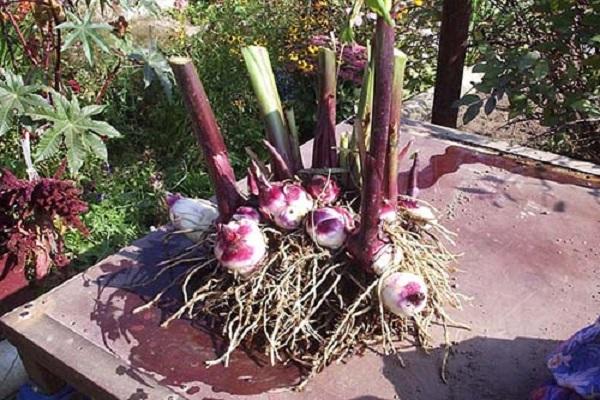

In room
At home, canna is stored in a cool room, for this, the plant is dug out of the ground and dried for 2-3 days, after which the root is sprayed with a manganese solution and placed in a box.From above, the planting material is sprinkled with peat and left until spring.
We save the plant with germination until spring
It is recommended to store cannes in pots until spring. The dug out plant, along with a lump of earth, is placed in a pot and brought into a cool room. For example, on the veranda, the culture overwinters in its usual conditions. You can also store the plant on a windowsill, periodically moistening the soil. Indoors, the air temperature should not exceed 13 degrees. Gradually, buds will form at the root, which will sprout in the spring.
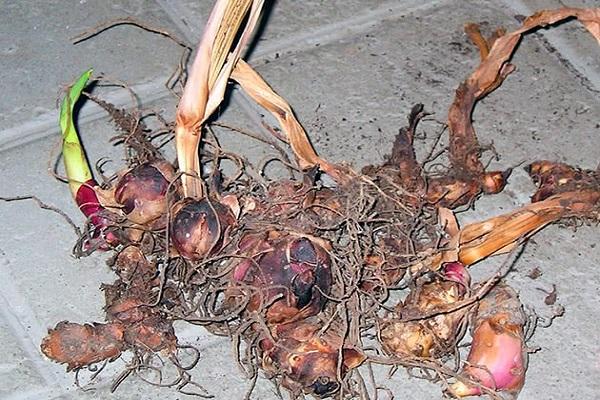

In a refrigerator
The culture can be overwintered in the refrigerator in the vegetable compartment. To do this, the roots of the canna are dug up and washed with water. After that, the planting material is dipped into a manganese solution for 5 minutes and laid out in a warm room to dry. After the roots are dry, they are placed on damp paper and wrapped. The bundle is placed in a bag and sent to the refrigerator until spring.
In the basement or cellar
You can properly store the tubers using the basement. To do this, you need to properly prepare the room:
- remove all unnecessary from the basement;
- remove mold from the walls;
- treat the room with an antifungal drug.
The excavated plants are dried for several days, after which the remains of the soil are removed from them. The tubers are placed in a wooden box and covered with peat or humus. From above, the boxes must be covered with cloth or paper.
Storage in pots
This type of culture storage in the room allows you to admire the flower all the time. In order to use this technique, it is necessary to prepare a pot of the appropriate size. The plant in mid-September is dug up along with the stem and transplanted into a pot. The culture pot is placed indoors on the sunny side.
In order for the flower not to die, care must be taken regularly, watering and feeding. Most often, cannes bloom until December, after which they go into a dormant state, in which case it is necessary to reduce the mode of watering the flower.
Description of the flower and its preferences
The Canna genus is the only one in the Canna family. It is a herbaceous plant, a perennial that grows in the tropical and temperate climates of India, China, South America, Mexico.
Canna is a tall plant, reaching, under favorable conditions, 2 m. The powerful hollow stem is covered with sessile smooth ovoid leaves, up to half a meter in size. Their color ranges from emerald to purple.
The flower is similar in shape to iris, its color can be scarlet, yellow, pink, white, have a light border or spots. Cannes bloom begins in June, and lasts all summer, until the arrival of cold weather.
Important! Canna is easily damaged by frost. It, like the dahlia, must be dug up in the fall, and stored until spring in a dry and cold place.
The nuances of care depending on the growing region
The landing period in the Moscow region is mid-May. The culture sprouts much faster and adapts to a new growth site. Seeds can be planted in the ground without prior germination.
Planting and caring for cannes in Siberia and the Urals requires more careful effort. The plant is recommended to be grown at home and planted in open ground only in mid-June. However, even with such a late planting date, regular shelter of the seedlings at night is required.
Reproduction
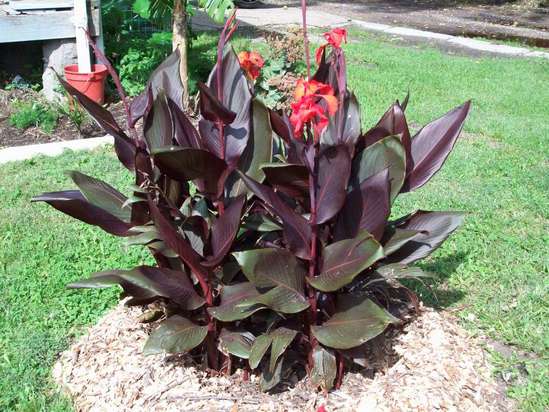

Most growers propagate cannu by dividing the rhizome, although there is also a seed method. The vegetative method is simple and effective.
In the spring, after a dormant period of the plant, it is carefully removed from the container and the soil is removed from the roots. Places of roots, stuck with rot, are cut off, the cuts are powdered with coal or sifted ash.
The rhizome is cut with a sharp knife so that on each part of the root there is a well-developed growth bud. The strips are placed in calcined wet sand and placed in a warm place until roots appear.
Advice. It is convenient to use transparent plastic pots as containers. The course of root formation is clearly visible in them.
Saplings, with well-developed roots, are transplanted into a nutritious substrate or open ground.
Classic flower problems and treatments
Like all types of flowers, cannes have a large number of diseases that can lead to a lack of color and the complete death of the plant.
Viral diseases
Diseases of the viral type rarely form on the plant, however, in the absence of proper care and a low amount of nutrients, the plant weakens and can be attacked by viruses.
Most often, the following types of viral infection can occur on a plant:
- Cucumber mosaic. This type of disease is carried by harmful insects. Also, improper care and the presence of weeds contributes to the transmission of the virus. The virus spreads rapidly through healthy plants and infects the entire area. To combat a viral infection, preventive measures must be taken. When infected, the disease does not respond to treatment, and the damaged culture is eliminated. In order for the virus not to manifest itself, it is necessary to fight aphids in a timely manner and disinfect all gardening tools before processing the crop.
- Variegation - the virus manifests itself in black spots that form on the leaves and stems. In the absence of timely treatment, it slows down the growth of plants and leads to a decrease in the formation of buds. To remove this type of disease, it is necessary to remove damaged leaves and sprinkle the cut area with charcoal or ash.
See also
Rules for planting and caring for perennial echinacea, 10 best varieties for open groundRead


Viral diseases are very difficult to treat, therefore, after planting in the ground, it is necessary to take preventive measures.
Getting rid of the fungus
Among fungal diseases, the following should be highlighted:
- Rust fungus - appears with frequent watering. It appears in the form of spots on the leaves of brown color. The affected plant dries quickly and dies off. To prevent disease, it is necessary to observe proper watering and regularly loosen the soil.
- Gray rot - appears in the form of plaque on the root and stem. The reason for the formation of this type of disease is soil moisture. The infected plant becomes covered with brown spots, the leaves quickly turn yellow and fall off. To reduce the fungus, it is necessary to maintain the distance between the plants and water directly under the root.
Phytoplasma disease
The disease manifests itself most often after an attack of harmful insects, leafhoppers. It is manifested by yellowing of leaves and deformation of leaves and inflorescences. When the disease appears, it cannot be completely cured, however, the use of chemicals with chlorothalonil prevents the formation of the problem.
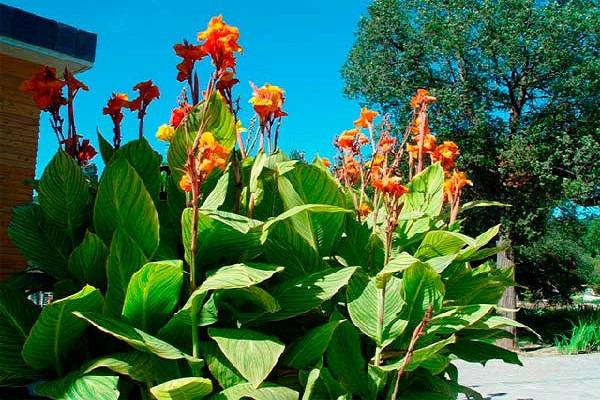

Leaf rollers
The pest very often affects the plant. On the leaves of the cannes, you can observe small larvae, which provoke the appearance of holes in the leaves. The pests feed on the leaves and cause them to turn yellow.
The presence of pests is manifested by the following symptoms:
- the appearance of black spots on the plant;
- the presence of butterflies and small larvae;
- leaves become lethargic and curl up into a tube.
To remove the pest, you can use special chemicals, such as "Fitoverm".
Thrips
The pests are small and immediately invisible on the plant. Insects and their larvae feed on leaves and stems. With a large accumulation of pests, the plant withers and dies. To remove thrips, it is necessary to plant marigolds around the perimeter, as well as spray the plant with preparations such as Actellik, Vertimek.
Spider mite
The pest feeds on plant sap and infects not only the leaves, but also the stems of the crop. When infected with a tick, a cobweb appears, and the plant becomes weak. Places affected by a tick have a large number of holes and gradually die off. To remove the pest, it is necessary to remove the damaged areas and treat the plant with the following preparations: Fitoverm, Aktofit.
Important. In order for the plant not to undergo this type of disease, it is necessary to use phosphorus and sulfur fertilizers..
Combination with colors
Cannes goes well with:
| Coleus. Flocus - landscape design |
|
|
|
|
|
| Marigold. Transfer of PRO flowers |
|
Prophylaxis
In order for the plant not to be exposed to diseases, prevention methods should be followed:
- timely remove weeds that can act as a source of infection;
- regularly loosen the soil for air circulation;
- when the first symptoms of pests appear, it is necessary to use chemicals;
- treat the roots with an antiseptic before planting.
The best way to fight disease is to maintain proper crop care. Timely and correct watering will preserve the plant and promote long-term flowering.
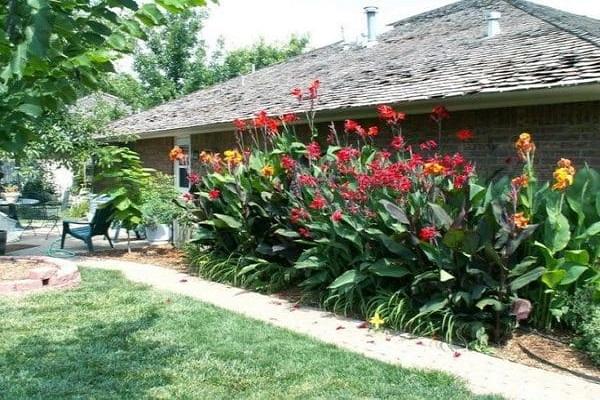

Diseases and pests of cannes
Canna has earned great respect from gardeners for its colossal resistance to aggressive environments. However, for the purpose of prevention, gentle treatment is carried out.
Fungal diseases are considered a threat to cannes.
These include the following:
- Gray rot. The botrytis fungus is formed when the environment is humid and cool. The first thing that will indicate a defeat is gray specks on foliage and trunks. The danger of this disease is that it easily spreads to nearby growing plants.
- "Rusty" mushroom. Formed with increasing humidity. At the initial stage of the development of the disease, the leaves are covered with brown spots, and later the fungus accelerates their early abscission.
Plants damaged by a fungal disease cannot be saved, so they are immediately destroyed.
For the purpose of prevention in the fall, they carry out:
- treatment with drugs;
- complete digging of the site;
- thorough cleaning of the territory.
Also, viral infections can become a source of cannes disease.
These include:
- Variegatedness. The lesion is easily identified by the presence of black appearance on the leaves. Usually the disease is not dangerous, it simply slows down the growing season. In case of a large lesion, the inflorescences of the plants twist, decreasing in volume. Treatment consists of removing the affected parts.
- Cucumber Mosaic Virus. The carrier of the disease is aphids. Leaves are mainly affected. Zonal chloroticity is observed, mosaicism can also be observed wrinkling of leaves and curvature. In order to avoid mass contamination of cannes plantings, the plants are constantly examined, removing infected specimens. Preventive measures include weed control, washing away aphids with water.
A sign of viral diseases is sharply yellowed canna leaves. There are insects that can harm plants.
The main ones are:
- Spider mite. It feeds on the sap of the plant. Favorable conditions for the spread of the pest are dry air. To reduce reproduction, it is recommended to increase the humidity of the environment by constantly spraying the plants.
- Shield. A dangerous pest that can destroy a flower. It inhabits the back of foliage and at the junctions of the shoot to the stem. An effective way to deal with a scabbard is to collect an insect from a plant with your own hands.
- Aphid. A pest living on young stems. It feeds on flower sap. Harms the development, growth of bushes. It is recommended to deal with shoot aphids using soapy water.
- Slugs.Plant-eating molluscs. To reduce the risk of their appearance allows loosening the soil, regular inspection for the presence of insects. Also from slugs they use soil mulching under bushes with cones or sawdust.
- Nematodes. Small worms that live off the roots of the plant. May appear when using organic fertilizers in combination with high soil moisture. Due to disturbances in the root system, the flowers lack moisture and nutrition. As a result, the development of the bush slows down and deformation appears. You can save yourself from nematodes by treating the soil with insecticides.
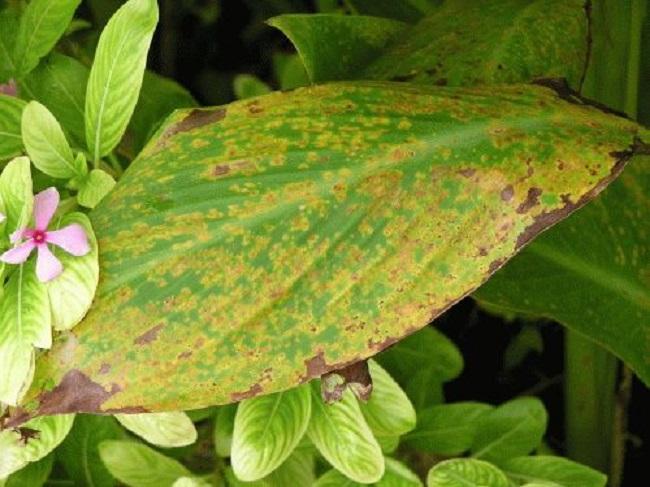

Fungal disease Shoot aphid Leaf lesions with cucumber mosaic
Flower reproduction methods
The plant can reproduce in several ways. The choice of breeding method depends on the personal preference of the grower.
Rhizome division
One of the simplest methods of culture propagation. For use, it is necessary to prepare the root on which there will be shoots. The root is split into several pieces. Each segment should have at least 2 buds. After the root is cut, the cut should be treated with manganese or wood ash.
Parts of the rhizome are placed in a warm place to awaken. Every 2-3 days, the roots are sprayed with warm water. Parts of the root must be placed in a mixture of peat and sand for two weeks. This period is sufficient for additional root processes to develop and the bud to sprout. Sprouted root parts are placed in open ground and covered with plastic wrap. So that the flower does not have to be re-planted, a distance of at least 60 cm between the holes is maintained during planting in the ground.
Seeds
Cannes seed propagation is used very rarely and can contribute to the emergence of new colors and forms of the plant. In order to plant a flower in open ground in spring, the seeds should be germinated. The seeds can be purchased at a specialty store or collected by yourself. Seeds are harvested after the plant has fully bloomed and formed a seed box. The seeds are large and hard shell. They rarely sprout without presoaking.
After the planting material is treated with boiling water and placed in the ground, it is necessary to regularly water the wells. Seeds are planted in pots and only after the emergence of seedlings is planted in open ground.


Cannes is one of the unique flowers that can be used to decorate the garden. The plant requires compliance with certain rules for care, otherwise it is often affected by diseases and pests, cannes can be grown not only in the open field, but also at home. The grooming process is no different, but the flower is large and takes up a lot of space, which often causes discomfort.
Description of the best varieties and types of cannes
Canna (Canna) belongs to the monotypic family Cannaceae (Cannaceae) and enter the order of the Gingerbread. Today it has about twelve species, which in natural conditions are common in Central and South America.
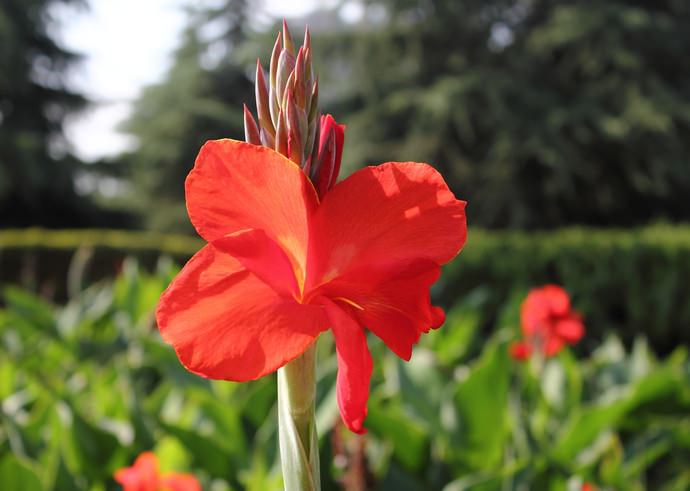

The flower grows in its natural environment in open and sunny areas, preferring moist and humus-rich soils. The flower catalog includes an incredible number of varieties, but the most popular were only the brightest and longest blooming cannes, which are easy to grow in a home gardening environment.
| Name of the species or variety | Specific or variety description |
| Indian | A slow-growing perennial with an erect, smooth stem and a powerful rhizome. The height of the aboveground part is 1.5-2.0 m. The foliage is elliptical, broadly lanceolate, leathery, dense, smooth, whole-edged, light green in color with red stripes, up to half a meter long.Flowers are few, tubular, no more than 8.0-10 cm in diameter, waxy, pinkish-fawn and red, collected in racemose inflorescences |
| Dangling | An evergreen perennial up to one and a half meters high, with a vertically located rhizome. The foliage is lanceolate, oblong, narrowed at the base, up to 50-60 cm long.Flowers up to 8 cm in diameter, yellowish-gray in color, with small attractive bracts |
| Sadovaya | Includes all modern hybrid garden forms, differing in size and coloration. Large-flowered varieties belonging to the Crozy group, as well as the Humbold variety with bright orange flowers and red-brown foliage and the unpretentious Tropicana Durban, are especially popular with flower growers. |
| Low | It has an aboveground part with a height of no more than one and a half meters. Under natural conditions, it grows in China. The foliage is distinguished by an oval-elongated shape, bright green coloration, up to half a meter long. Reddish-orange flowers, no more than 8.0-10 cm in diameter, collected in attractive inflorescences |
| "America" | The stem of the ornamental culture is 1.2-1.4 m high. The flowers are large, up to 10-12 cm in diameter, purple-red in color, collected in relatively long inflorescences. Foliage reddish purple |
| "German Titov" | The stem is erect, strong, no more than 1.1-1.3 m in height. The flowers are relatively large, light beige-pink, collected in relatively long inflorescences. Foliage reddish green |
| Clara Buisson | The aerial part is represented by upright stems no more than 1.1-1.2 m in height.Flowers of bright, reddish-orange coloration, collected in attractive and relatively long inflorescences |
| "Andenken an Pfitzer" | The aerial part is represented by upright sturdy stems up to 1.2-1.4 m high. The flowers have an attractive orange coloration with quite pronounced strokes of red at the base. Foliage brown-purple |
| "Sunny Beauty" | The height of the above-ground part does not exceed one meter, with quite good foliage. The flowers are light beige-yellow or cream colored, collected in relatively long and attractive inflorescences |
| "Wyoming" | Bushes are represented by stems no more than one and a half meters high. The flowers are juicy and rich orange, up to 10-12 cm long. The flowering is very abundant and long lasting. The varietal feature is the preservation of decorativeness throughout the season due to the bronze-brown foliage. |
| "Confetti" | A medium-sized plant forms stunningly beautiful flowers of a creamy yellow color with numerous and clearly visible brownish-pink blotches |
| Lucifer | The medium-sized plant is distinguished by bright red flowers with a pronounced yellow border. The foliage is green, wide enough, with slight waviness at the edges. Flowering continues until mid-October |
| "Chisinau" | A feature of the varietal color is an interesting distribution of different shades across the petals. The main color is red. There are also yellow edging and veins. The height of the plant does not exceed 1.2-1.3 m. The foliage of the aboveground part is good. The foliage is rich green. |
| "Picasso" | The variety is highly regarded by flower growers and landscape designers for its incredibly attractive and bright yellow petals with pronounced oblong blotches of orange-red color. The diameter of the flower does not exceed 12-13 cm with a total height of the stems at the level of 80-90 cm |
What to do with the canna after flowering
To recuperate the room canne after flowering, you need to give time to rest.
You need to start gradually:
- At first, the amount of watering is reduced daily, and then completely stops.
- The leaves are then trimmed to preserve the sap inside the plant.
- The flower pot is removed in a place with a temperature of at least 10 ºC.
With the onset of spring, the roots are revived, removed from the soil, and planted.
After flowering, the garden cannu gradually ceases to be watered. With the arrival of autumn, the stems are disposed of, and the rhizome is dug out together with an earthen lump. It is better to dig out rhizomes at the onset of the first frost. If you get it before frost, the roots will not have time to gain the nutrients necessary for wintering.
A bit of history
Kanna got its name from the word kane, which means "stem" or "reed" in Hebrew. That is, a plant with an empty trunk, which is quite true. Canna was first introduced to Europe in 1570, most likely from the Antilles. However, for a very long time it was grown in gardens only as an ornamental plant.
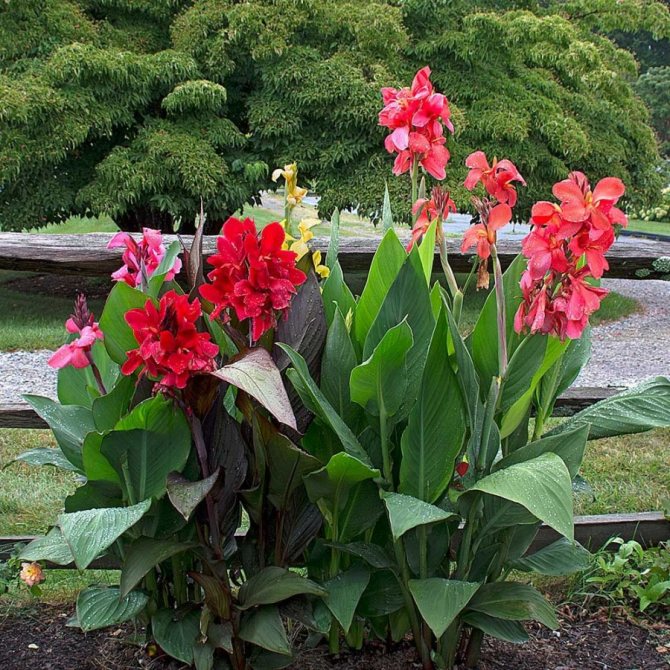

In 1859, Mr. Annet, a gardener from Poissy (France), made the first attempts to breed a canna with a beautiful flower. However, Mr. Crozy from Lyon managed to create truly amazingly beautifully flowering varieties: in 1889 he received the first large-flowered Cannes variety, named after his wife M-me Crozy.
Cannes varieties
Asian. The common ancestor of all modern species of Cannes is the South Asian canna. She was given the name of the garden canna, due to the domestic types, bred as a result of the long-term work of breeders. As a result of the selection, three hybrids were bred.
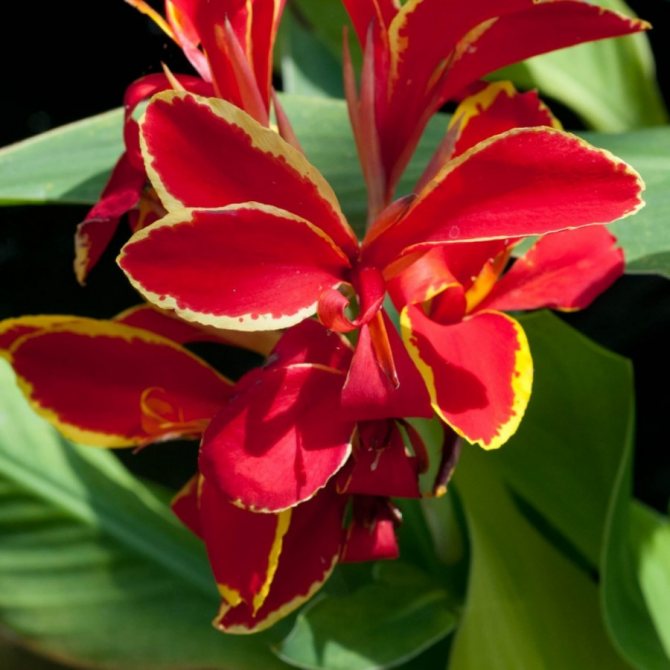

Canna Crozi is a plant that looks like gladioli. The species is distinguished by its short stature, its average length is 100 cm. The flower petals have a beautiful purple or dark shade of green with a white bloom.
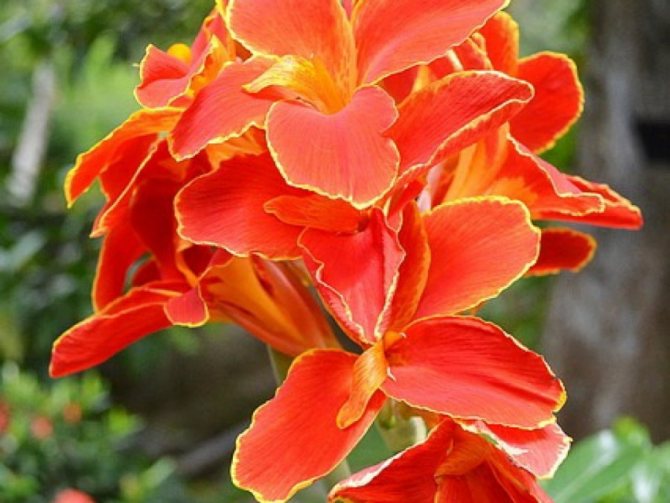

The initial Crosey hybrid was obtained back in 1868 and after, many varieties of it were formed. The best of them are: Livadia, America and the President.
Cannes varieties: photo
Cannes problems
The flower plant is susceptible to diseases and various types of pests.
| Disease / pest | Symptoms | Remedies |
| Viral diseases | Yellow stripes develop along the veins and on the leaf. Then faded spots appear, plant development is delayed, late flowering. | There is no cure. Dig up and destroy the plants. |
| Fungal diseases: rust and gray mold | Orange spots all over the plant. Brown spots along the flower. | Adjust the moisture content of the ground and the surrounding air. Increase circulation. Adjust the temperature. Spray the leaves: ¼ teaspoon chlorothalonil per liter of water. Repeat the procedure after 10 days. |
| Phytoplasmic disease | Leaves turn yellow, shrivel, grow deformed. | Destroy the diseased plant. |
| Leaf rollers | The appearance of holes in the leaves, eaten by insects | Set traps or collect manually. |
| Spider mite | Yellow bumps on the leaves. | Treat with horticultural oil, insecticidal soap or solution. Tear off old lower leaves periodically. Reduce watering and nitrogen fertilization. |
| Thrips | Transparent or yellow spots. |
Reproduction at home
You can grow a canna yourself in two ways - by sowing seeds or dividing an existing bush with a root. Growing seedlings from seeds carries some risk, as seedlings often show visible deviations from the original variety. If it is necessary to obtain a certain variety with an identical color palette, it is better to use the method of dividing the rhizome.
Propagation of canna seeds
Cannu sowing for seedlings begins in February. But this process is preceded by a mandatory "hard" seed treatment - they must first be kept in the cold for a couple of hours, then doused with boiling water. The prepared seeds are deepened into a container with soil and placed in a bright, warm place. In a month, you can expect the first shoots. At the end of March, the first pick is carried out into small pots, up to 15 cm in diameter.On the garden plot, they can be placed at the end of spring, while choosing a site that is closed from wind and draft.
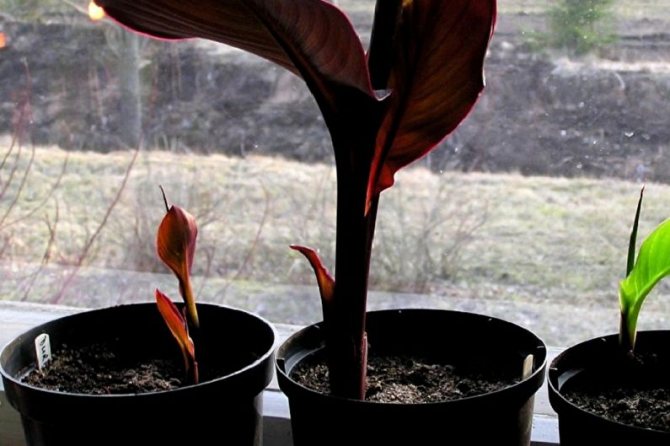

Canna propagation by dividing the rhizome
This is a fairly simple and effective way to get new representatives of your favorite Cannes variety. In September, it is necessary to carefully remove the rhizome and transfer it to a cool room (cellar). At the end of March, the root is divided in such a way that each cut off part has at least two buds. Slices must be treated with charcoal. The resulting blanks must be sent to the greenhouse, sprinkled with earth on top. With the appearance of full-fledged leaves, the bushes must first be placed in pots, and only in June they can be moved into the ground.
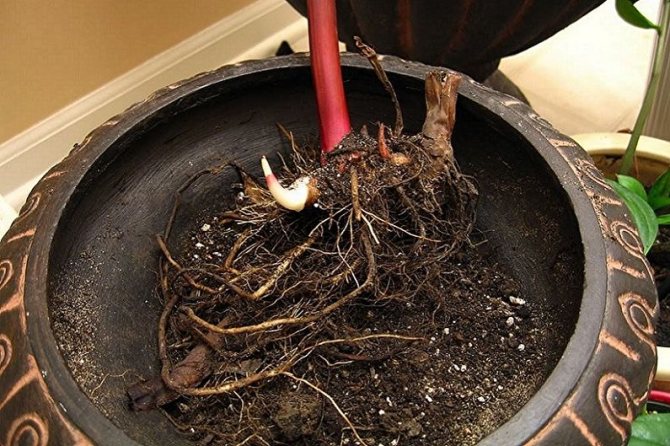

Popular varieties
By and large, representatives of the entire family have unique traits and features that clearly indicate an exotic origin. But here it is not complete without favorites.
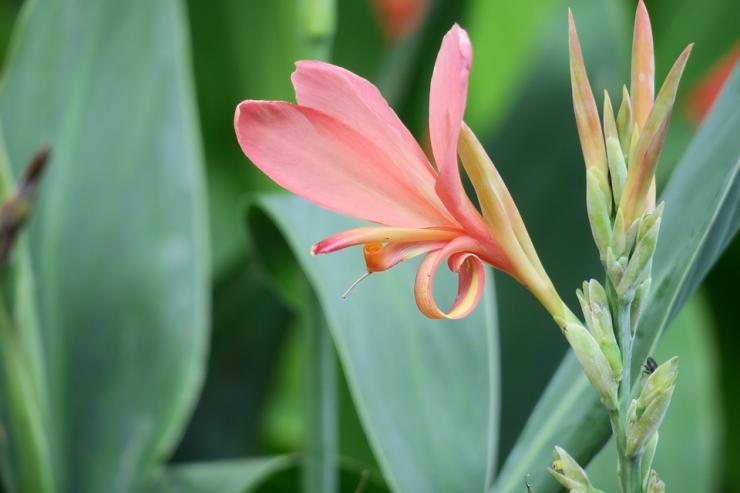

Indian
Most of the now popular varieties were bred from the Indian. The resulting crops are collectively called Garden crops. For example, these include: crozy, orchid and few-flowered.
Durban
While you thought that two meters is too high for flowers, dope conquers three rubles. In other words, if you plant them along the wall of the house, then you can only smell the flowers from the second floor. True, this will be pointless, since all flowers in this family do not have any smells at all.
Orchid cannes
A giant variety, a full-fledged representative of its kind. The shortest stems grow at least one meter, and the tallest ones reach all two. Flowers to match the stem - up to 18cm in diameter. The colors, depending on the variety, are red, orange, yellowish, speckled and shaded with a second color.
Salmon Pin
A short member of the family, but no less interesting. The unique property of the variety in striped salmon flowers, which makes it an irreplaceable decoration of the garden, which a professional designer will not disdain.
Flowering period
Canna is one of those few plants that have an enviable flowering period. It can last from 3 to 4 months and makes up a significant part of the growing season. Therefore, when a canna flower blooms, how to care for a perennial worries many inexperienced florists.
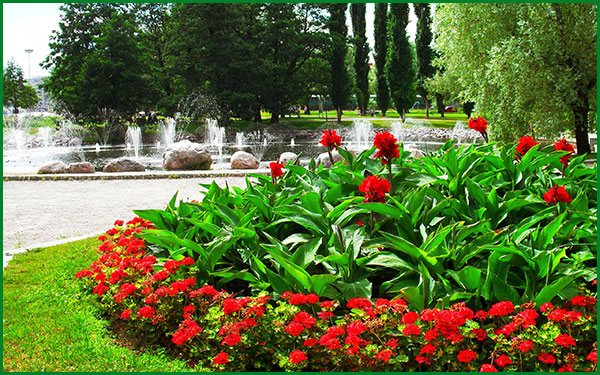

Cannes in landscape design
First of all, don't be afraid to cut flowers regularly. This will prevent the seeds from setting, which prevents the formation of new buds. The procedure is performed with a sharp instrument, for example, a pruner.
Important! If the cannes do not want to bloom, the reason for this behavior may be the lack of enough light. Watch during the day for a lacy tree crown or hedge shading your flower bed.
The history of the origin of the flower
Such an unusual and attractive flower simply cannot grow without a beautiful legend. In Latin, the name of the plant is translated as "tube". According to legend, such a plant, which very much resembles a torch, grew for the first time on the site of a fire. The Indian chief burned the treaty and led the population of his country to a bloody and terrible war. On the site of this fire, a plant grew, the flowering of which can be compared with a bright fire.
Cannes appeared on Russian soil about 400 years ago, became widely known because of Peter the Great and his garden office. The place of origin of the culture is the following countries: India, China, and the plant is also widespread in America. Here for him there are the best climatic conditions: a lot of sunshine, heat and sun.
Despite the fast growing perception of being demanding, the canna flower doesn't need anything special to grow. It is only necessary to comply with all conditions and requirements important for its growth, and then the plant will bloom and grow beautifully on the territory of the front garden.
Use in landscape design
Flowers are usually planted in numerous groups to show the maximum beauty of the flower. Cannes looks good in a variety of compositions:
- near the pond;
- against the backdrop of the lawn;
- as a discount element;
- in the composition on the flower bed;
- used for planting in pots, containers on terraces, balconies - varieties are planted, the height of which does not exceed 60 cm;
- the plant is often an element of urban greenery.
Canna is one of the most popular flowering plants in the garden. Her intensely colored flowers are a very interesting element in every flower bed. The unusual shape and vibrant color make the plants a little exotic. Knowing how to care for cannes, it is easy to achieve beautiful blooming of huge flowers in your garden.
A magnificent garden is the right choice of plants that have properties that allow them to coexist with other representatives of the flora and give excellent flowering over a long period of time.
Today we will look at the question of how to create the luxury and grace of a tropical Mediterranean flower garden with minimal financial and labor costs.
Canna flowers are native to the tropical climatic zone and require careful attention to all vegetative forms throughout the entire period of their cultivation. They do not grow in the wild on the territory of our country.
The most common cultivated species is the Indian Canna (Canna indica), which has magnificent buds, a strong fleshy stem and a long flowering period.
The plant belongs to the Cannaceae family or monocotyledonous group. The average period of plant development until the moment the flower branch is ejected is 4 months. Flowering lasts up to 2 months.
Some types of crops can reach a stem height of up to one and a half meters.
Leaves located on short cuttings are located opposite each other. They have longitudinal leathery veins. The buds have an exotic shape that resembles big ears, the color is very diverse - from bright yellow to a rich burgundy hue.
An interesting fact is that in some regions of South America, cannes tubers are eaten. They have a pleasant sweetish taste, similar to that of potatoes. In other regions, cannes flowers are used exclusively as an ornamental park culture.
If, during the flowering period, the buds are pollinated by insects, then the seeds ripen, they are round, dark brown in color. They are used for seed propagation. Although you can get flowering buds much faster when planting adult tubers.
Look at the cannes flowers in the photo, illustrating the richness of shades and the possibilities of their use in landscape design:


Deciduous Cannes
The tallest plants in Cannes reach a height of 3 meters. They have very picturesque leaves of various shades, but the flowers are small, only 6 cm.


The most popular Durban variety is a flower with yellow and orange hues and beautiful leaves that will be a real gem of any garden. Choose a plant to your liking, and numerous photos of Cannes on the Internet will help you make the right choice.
Care Tips
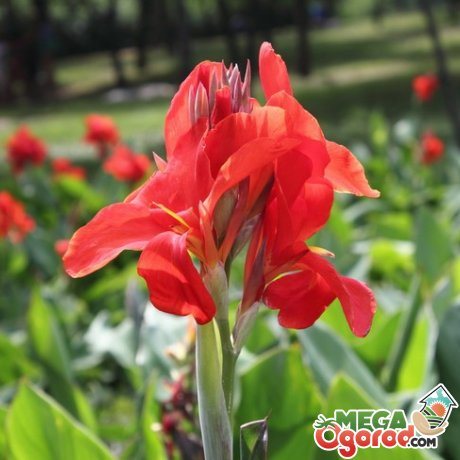

In order for the plant to grow quickly and delight with lush greenery, abundant watering is required. After planting, the seedling should be irrigated with 10 liters of water. The main task is to ensure that the ground around the sprout does not dry out, but remains constantly moist. But it is not recommended to bring the soil to a swampy state. In this case, there is a possibility of tuber decay.
At the time of flowering, watering is further increased.
In order for the land to constantly remain moist, and watering does not increase at certain periods, the soil around the bush will be mulched. In addition, the plant must be fed with mineral fertilizing (after watering, add fertilizer granules to the soil by loosening it).
It is necessary to make a mixture consisting of 25 gr. phosphate, 12 gr. nitrogen and 10 gr. potassium, that is, 40-50 gr.fertilizer or use the universal fertilizer Nitroammofoskoy. This amount is required to be distributed over an area of 1 m2. Thus, care for the culture is minimal and not difficult. But the shrub will respond with lush color and greenery.
Plant propagation
The simplest and most effective method of propagating these flowers is by dividing the root. To do this, in the spring, at the end of March - early April, the rhizome is taken out of the clod of earth in which it was stored all winter, cleaned of decayed areas and divided into kidneys. Places of cuts are disinfected by sprinkling with coals or ash.
Advice. If two kidneys are close, leave both.
Delenki are planted in boxes with earth or in pots in a greenhouse with a temperature of 20-24 ° C. When the culture sprouts, the temperature is lowered to 16 ° C. For rooting, the delenka can be watered with a 2% solution of potassium permanganate every 10 days.
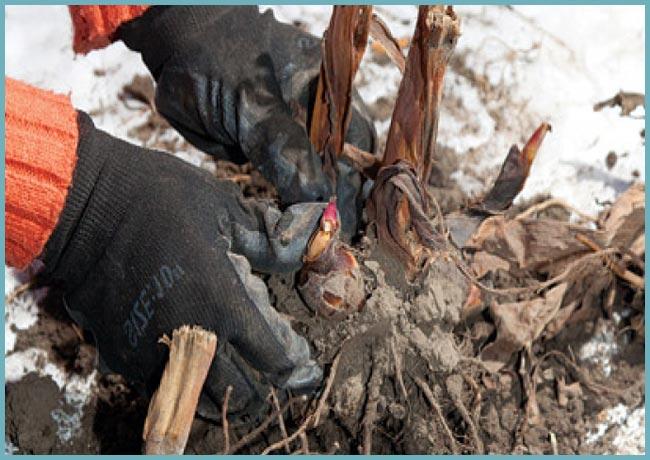

Dividing the cannes bush
Let's say a few words about common varieties
Well, now let's say a few words about what varieties and varieties exist. Canna flowers have been the favorites of breeders for several centuries. Therefore, the existence of many varietal varieties is quite understandable.
Let's talk only about the brightest of them, since a full catalog can take up a hundred pages of text and no less pictures.
Indian canna is the most common species, distinguished by its relative unpretentiousness to the conditions of its growth. This plant is considered the progenitor of all varietal species.
Crosey belongs to the dwarf types, the stem grows only 60 cm. This is compensated by fantastically beautiful buds that resemble gladioli. The leaves are initially dark, rich green. Gradually they become burgundy and purple.
If you want taller plants, then you should pay attention to the "America" or "President" variety. They have a tall stem over 1 meter in height. The bright red buds are beautifully framed by gorgeous glossy foliage.
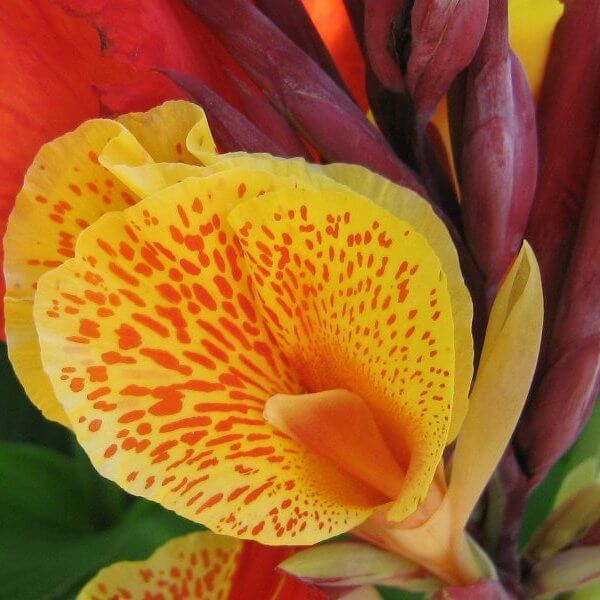

Orchid cannes are similar in their inflorescences to cattleyas. Their stems reach a height of up to 2.5 meters. The buds are simply huge, they reach 20 cm in diameter. And leaves corrugated along the edges complement the unusual and fantastic picture.
You should not pass by deciduous varieties that do not have such outstanding buds, but their deciduous mass will give odds to any even very beautiful flowering plants.
The height of the variety reaches 3 meters. This amazing property allows them to effectively decorate the fence line and delimit the landscape design of the site.
Variety "Durban" provides an opportunity to use unusual striped leaves in composing a composition for any garden on the backyard.
Look at the varieties of Cannes flowers in the photo, the magnificent splendor of their flowering is shown:
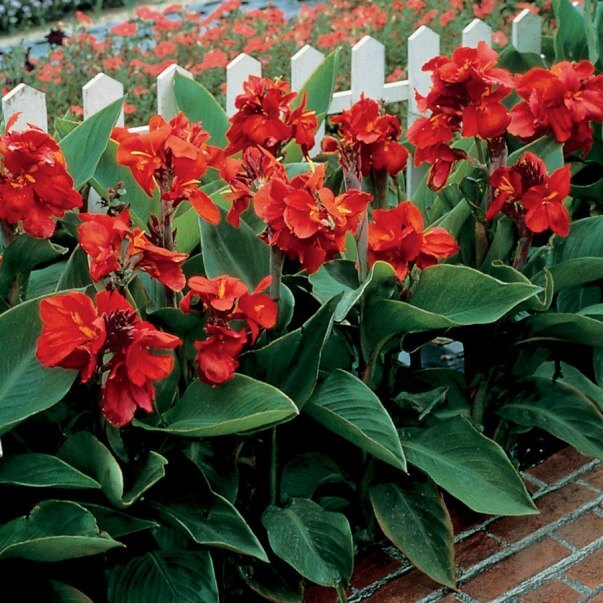

Hello everyone, my name is Natasha! I love plants and decor. I make florariums, collect a collection of plants, maintain a pharmacy "vegetable garden", and also maintain a blog lovgarden for everyone who is passionate about the theme of the garden, vegetable garden and plants as much as I am.
Indian canna in garden design
Of course, such a magnificent plant will find its rightful place in the front flower garden, in its central part you can arrange a group of tall cannes of the same color, and plant less tall flowers around in a contrasting combination. Especially impressive looks Indian K. as a tapeworm in the center of a round regular flower bed.
Do not forget that the canna stem is single, so it is better to plant it in a group, then it will create the effect of an unusual luxurious shrub.
Smaller varieties of cannes alternate well with other plants in flower borders.
If you remember, Indian canna naturally grows along the banks of rivers and streams, where there is excessive moisture. So, if you have an artificial reservoir on the site, then the canna can be planted as a coastal plant.Moreover, it can even be planted in the pond itself by placing the plant in a large basket or pot and placing it in the pond so that the water lightly covers the surface of the soil in the pot. The canna flower is blissful in this position and soon turns into a strong, lush plant.
K. indian can also be grown as a container garden plant, but it is important to choose a good sturdy container so that its powerful roots do not deform it. With this option, the tub with a canna is kept on the terrace or patio until the coldest days, and then brought into the house, where it continues to delight everyone with its flowering almost until the New Year.
<2010 - 2019, Planting a Garden. All rights reserved.
Similar posts
Freesia: southern beauty in the garden
Exotics from the supermarket
The humble charm of the geranium
Canna planting and subsequent care (propagation by seeds and rhizome)
Reproduction by seeds and rhizome is allowed, which can be divided in the autumn after the completion of the flowering process. Sowing seeds should be done as early as possible, the best period is the end of January and beginning of February.
Before sowing, canna seeds must be thoroughly wiped with sandpaper in order to partially destroy the strong protective shell. Without this event, germination may deteriorate, the timing of emergence of shoots may be delayed up to 4 months.
After filing, the seeds are soaked for a day in a nutrient solution of growth stimulants. Then sowing is carried out in the prepared nutrient soil. For these purposes, any soil for indoor plants is suitable.
The container with the sown seeds should be placed in a warm place. Only at temperatures above 25 degrees Celsius can you wait for shoots.
Planting cannes by dividing the rhizome is the easiest and most reliable way to propagate a culture in a personal plot.
The seed method is more recommended for breeding work, since seedlings may not retain their species and varietal qualities. Sometimes we get very interesting fantasy color combinations in the petals of the buds.
With proper sowing, seedlings can appear after 4 weeks. In the phase of 2 true leaves, planting is carried out in separate containers for seedlings (picking).
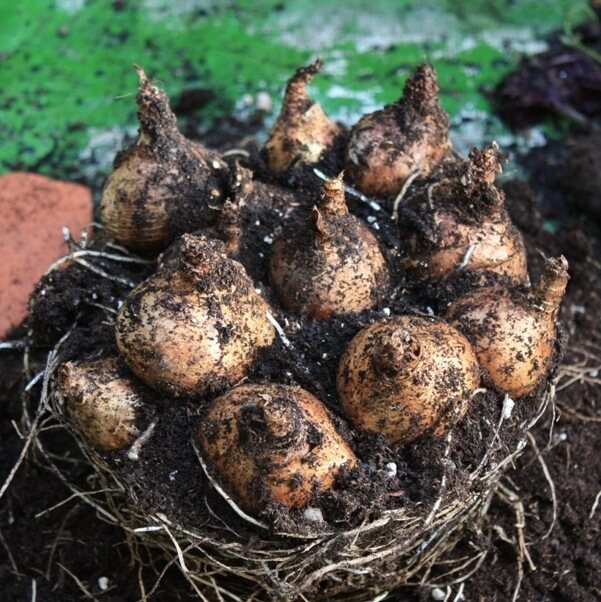

Rhizome propagation is a fairly simple way. For this, an audit of overwintered rhizomes is carried out in March. It is divided according to the principle - so that 1 flower bud remains on each segment.
Sections are processed with wood ash or crushed activated carbon and dried. After that, all the rhizomes are placed in a container and covered with calcined sand.
Watering is carried out every other day. The container is covered with plastic wrap and placed in a bright place.
Ideal conditions develop on a windowsill that faces the south or east side of the house and under which a heating radiator is located. In this case, the leaves will appear quite quickly (after 2 weeks).
After that, cannes are planted in separate pots with nutrient soil.


Germination of canna tubers is a must in our difficult climatic conditions. Only in this way can you get abundant and long-lasting flowering. It is not worth planting non-sprouted tubers, since they will not have time to release buds.
Cannes are planted on a personal plot in open ground no earlier than May 20. By this time, the threat of recurrent frosts on the soil should have passed. Already grown plants with a stem height of up to 80 cm are planted.
A suitable soil is prepared before planting. A high degree of soil fertility is required - compost or humus, complex mineral fertilizer are applied.
When planting and subsequent caring for cannes, experienced florists use various agrotechnical tricks. So, the “warm” pillow gives the best result. For its arrangement, a trench is dug, the entire layer of earth is removed from the ridge.
A thick layer of hay or fresh manure is placed on the bottom.Then the earth is poured back. Due to biochemical processes taking place in the layer of hay, a constant flow of heat to the root system of the canna is provided. At the same time, the plant blooms 2 weeks earlier.
The planting depth of the rhizome is up to 15 cm. Do not cover the growth point on the stem. Subsequent plant care consists of regular watering. once every 10 days, when watering, add a few grains of manganese to the watering can. This stimulates flowering.
Top dressing is carried out using the root method. Preparation of a solution for dressing: for 10 liters of water, 20 ml of organic complex fertilizer "Ideal" and 1 tbsp. spoon of Agri-Cola mineral additive for flowers. Everything dissolves thoroughly. 10 liters of solution is enough to water 10 plants.
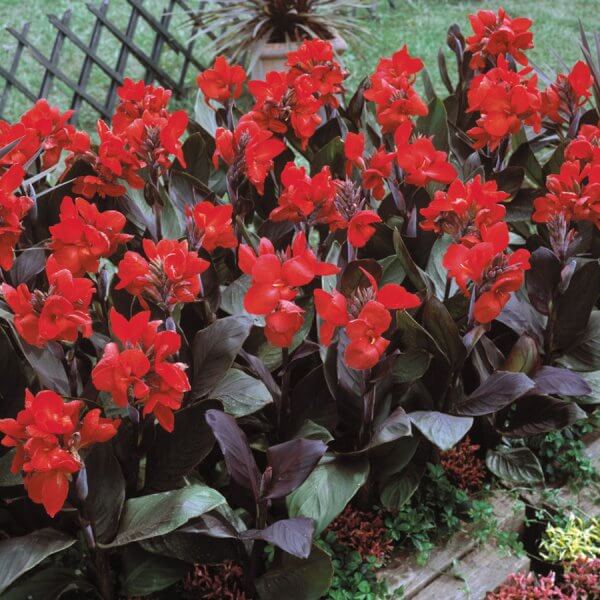

Cannes flowers - a little about the plant
Canna is a tropical plant that came to us from South America and Asia. Due to its tropical, heat-loving disposition, it does not quite tolerate our harsh winters and needs to be dug out for the winter. But this is a trifle in comparison with the pleasure of growing such a miracle in your flower garden. And canna is really good. At the same time, it is remarkable not only for its magnificent flowers, which resemble a kind of symbiosis of gladioli, irises and orchids. But even without the presence of flowers, cannes attract attention. Its high stem is covered with magnificent wide leaves of rich green, burgundy or pale emerald color with a waxy bloom. They are very similar in shape and size to banana leaves. To date, many varieties and hybrids of cannes have been bred. They differ not only in stem height - from half a meter to three meters, but in a variety of shapes and colors of flowers. The traditional color of canna flowers is red. It is they who can most often be found in city flower beds. But cannes of pink, yellow, orange colors are no longer uncommon. There are also two-tone and speckled colors. The beauty of this plant is that it can be grown with equal success both outdoors and in a pot, as a houseplant. True, they are mainly grown undersized varieties. Orchid cannes, which got their name for the similarity of flowers to those of the Cattleya orchid, are best suited for this. They are only slightly more than a meter high, and they will not take up too much space.
Fertilization and feeding
Cannes are fed with mineral fertilizers three times during the growing season. A mixture of potash, nitrogen and phosphorus fertilizers in a ratio of 10:12:25 is required for 1 square meter. Fertilizer granules are scattered around the bushes after watering, and then the soil is loosened.
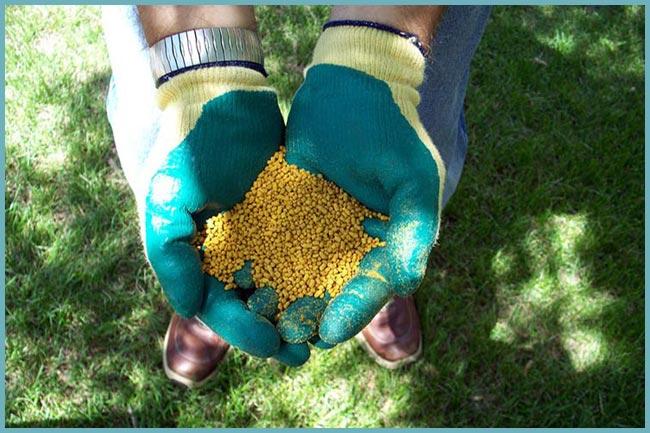

The culture needs regular application of mineral fertilizers
Varieties
Canna is the only representative of the Cannev family and has about 50 varieties. This bright perennial fell in love with breeders for its ability to give life to hybrids of extraordinary beauty.
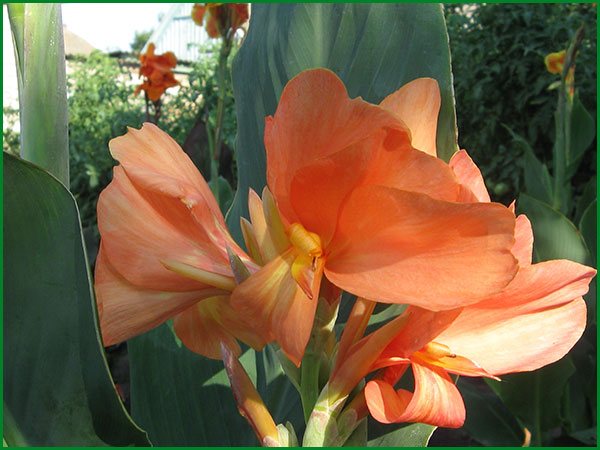

Canna Sunset Flare
The leaves of the perennial canna have a decorative look, a flower - a photo of plants makes you fall in love with large candles of unblown buds, a leopard or contrasting two-color color of petals, crowning a tall straight stem in a rosette of purple, burgundy, striped leaves.
Among the varieties most suitable for personal plots are:
- Crimean Dawns;
- Livadia;
- Reflections of the Sunset;
- Gift of the Crimea;
- The president;
- Richard Wallis;
- Sunny Beauty.
Cannes features


Externally, the canna bush is similar to a hybrid of an orchid or gladiolus and a banana. Such a plant has a couple of disadvantages, namely: when grown in mid-latitudes, its flowers do not have a scent, and it can also freeze out in too cold winter. And the rest of this plant is completely satisfied with gardeners.
Canna is highly resistant to disease, so even an inexperienced gardener can cultivate it. This plant is very effective and is distinguished by its unpretentiousness and drought resistance.It blooms for a very long time from the last days of June until the first frost. The branching rhizome of the canna grows in breadth. Erect flowering stems are high (60–300 cm) and thick. Powerful large leaf plates are pointed, their shape is elliptical or oblong, their length can vary from 0.25 to 0.8 m, and width - from 0.1 to 0.3 m. Due to the color and shape of the foliage, the plant looks very impressive. But it looks most decorative after its incredibly beautiful flowers open. Bisexual sharply asymmetric flowers have a size of 40 to 80 mm, they have a red color. As a result of breeding work, varieties with flowers of pink, yellow and orange appeared, there are also bordering, bicolor and speckled varieties. The rarest are cannes with white flowers. Flowers are part of racemose or paniculate inflorescences. The fruit is a three-nested capsule.
Description of the plant
The canna flower (Canna) belongs to the Cannaceae family and includes several dozen plant species found in the tropical regions of North America, South America, Asia. Typical species - Indian canna (Canna indica). In home gardens, numerous, more decorative hybrids are mainly cultivated.
Garden canna (Canna x generalis), known simply as canna, is characterized by ovate-lanceolate leaves arranged on tough, hollow stems ending in an inflorescence. It is an extremely original perennial plant - grown for the decorative and exotic leaves and vibrant flowers that adorn the garden from July until the first frost.


The plant forms beautiful, very original flowers with an asymmetrical structure and a characteristic panicle inflorescence. Flowers are often very intensely colored:
- red,
- Orange,
- pink,
- yellow.
Currently, there are unique varieties with a touch of salmon or apricot, two-tone varieties with a contrasting color are popular. Stamens protruding from the petals add decorativeness.
Cannes can grow up to 2 meters, the height of the plant depends on the variety.
Cannes rhizome contains a lot of starch; American tribes ate it baked.


Cannes storage
As soon as the first frost approaches, you must first cover with a not very dense layer of earth or sand.
After the first light frosts, the cannes digging procedure and preparation for winter storage takes place, which consists of the following stages:
- Digging cannes. Occurs in dry weather. It is necessary to retreat as far as possible from the stem itself and evenly dig in the root from all sides, so as not to harm.
- The aerial part of the flower is cut off and the stem is left at a height of about 20 centimeters.
- The roots, together with the soil that remained on the stem after digging up, should be placed in containers with holes, which will provide air intake. It is important to leave the soil on the roots because it will help prevent the roots from drying out.
- If there are several varieties, it is necessary to hang labels with inscriptions on the stems.
- The best storage space is considered to be a basement or other cool room.
- The temperature must be kept at 10 ° C.
- Air humidity should be at the level of 70-90%
Mr. Dachnik recommends: canna in the landscape
Cannes is good both in group plantings and planted one at a time, therefore, is loved by landscape designers. It is good to plant against the background of undersized plants: marigolds, coleus, cineraria. Combine with cochia, perilla and petunia.
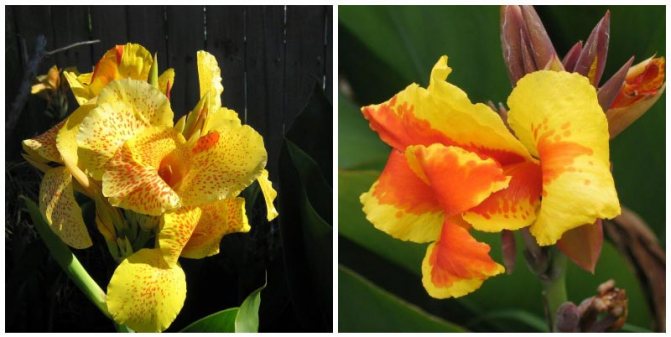

Orchid
When planting with other flowers, they provide a central position, placing medium-sized and low flowers around. For group planting, they are placed in the form of wide and long ridges.
Summer balconies, loggias and terraces are decorated with flowers, planting them in a flowerpot or large tub.
2.Kanna - care and storage
2.1 Keeping in the open field
Landing in open ground is possible as rhizomesand seedlings - small plants that have been previously grown in a nursery or at home.
Canna seedlings will need preliminary hardening - small plants are kept cool, when temperature about 16 ° C.
Before planting in open ground, the plants begin to move outside for several hours a day, gradually increasing the time they spend in the fresh air.
Rhizomes can be planted outdoors, in the garden, both with the appearance of new growth, and in the absence of it. If the rhizomes were not previously germinated, then the appearance of the first buds should be expected at a later date. If the plants are grown in cool climates, then flowering may not occur at all.
↑ Upward,
Landing is carried out in the second half of May - when the last spring frosts recede in the regions.
As a location, you should choose a site where the flowers will be protected from strong gusts of wind, and also where there is no groundwater close to the surface in the ground. For several hours a day, direct sunlight should fall on the cannes planting site.
It is advisable to plant plants with south, southeast side buildings - such specimens will additionally receive heat from the walls at night.
The plot for growing cannes is pre-dug up and weeds are removed from it, and they are also prepared forsedimentary holes depth and width order 60 cm.
↑ Upward,
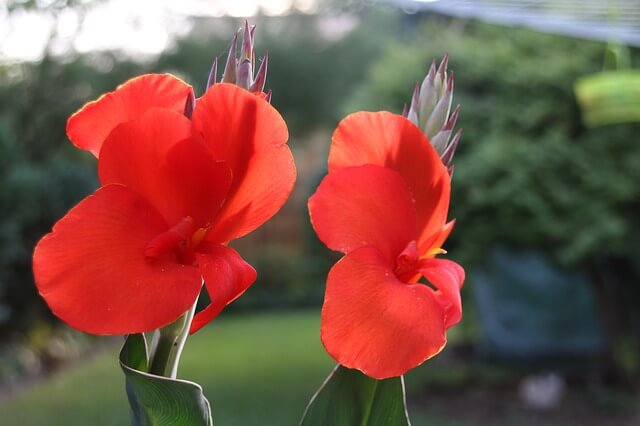

The placement scheme will depend on the height of the particular canna variety and the growing method - undersized varieties can be at a distance from each other 30 - 50 cm., while high cannes should be located at a distance 60 - 90 cm... apart.
The flower can be used both in group plantings and single plants.
Before planting, the rhizomes are examined, the diseased and rotten areas are removed, the wound surfaces are smeared with brilliant green or charcoal is sprinkled on the wound surfaces and slightly dried. Can soak roots for 30 minutes in a weak solution potassium permanganate.
First of all, a layer of expanded clay, crushed stone or river pebbles is placed on the bottom of the planting holes. You can also use fragments of clay pots or just broken brick as a drainage layer.
↑ Upward,
Too heavy substrate is pre-mixed with river sand to improve moisture permeability. Nutrient-poor soils are enriched with the addition of humus and humus or well-rotted cow or horse manure. Good amount of nutritional organics (manure) is placed on the drainage layer, in the holes.
The manure will not only nourish the plants during growth and flowering, but will also give the roots extra warmth.
Sprinkle the nutrient layer with earth - about a layer thick 20 - 25 cm... The rhizomes are located at a depth 6 - 9 cm... from the surface of the soil, depending on their size and sprinkle with earth.
After planting, the soil around the plant is well tamped and the flowers are watered.
↑ Upward,


Further care of the plants will consist in timely watering and feeding, loosening the soil and weeding.
Remember that insufficient watering can inhibit bud formation, and the bushes produced in drought conditions will be much smaller.
Feed cannu 2 - 3 times from spring to autumn, using mineral fertilizers. The first feeding is carried out immediately after planting, the second - before the onset of flowering, and the last one is done immediately after flowering, to prepare the rhizomes for winter - so that they have a supply of nutrients.
Wintering in the conditions of the middle lane, it can end in death for the flower, therefore, the rhizomes of the canna in the autumn months are dug up, dried and stored until spring in a cool and dry room.
The first frosts of plants can be carried out in the garden, but before their onset, the plants should be protected by covering the roots with an additional layer of soil.
↑ Up,
Before digging out the entire ground part cut off sharp and sterile pruning shears at a height of 15 - 20 cm.
Rhizomes are dug up, cleaned from the ground, soaked in a weak solution of potassium permanganate for a day and dried, placed in cardboard boxes or wooden boxes, allowing the roots of the flower to breathe.
A small amount of a mixture of coarse river sand, sawdust, peat and garden soil is placed between the rhizomes. The sprinkling soil should be kept only slightly moist by spraying it from a spray bottle. You can also store the rhizomes in slightly damp river sand.
↑ Up,
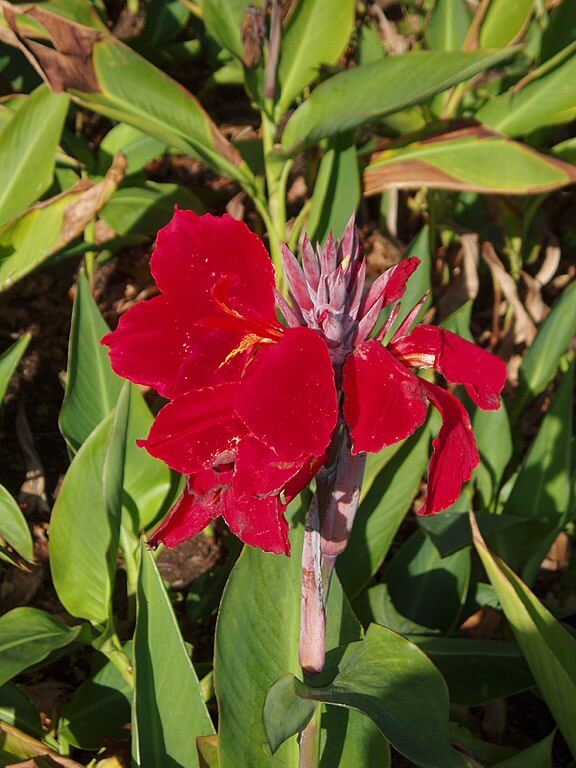

The storage room must have temperature within 6 — 8 ° C... From time to time, the rhizomes are removed from the box, carefully examined for rot and treated, if necessary, with fungicidal preparations.
You can use the vegetable shelf in the refrigerator for storage space.
In more southern regions with a frost-free climate, before the onset of winter, the canna roots are additionally sprinkled with a layer of soil and covered with spruce branches or fallen leaves to protect against frost.
↑ Up,
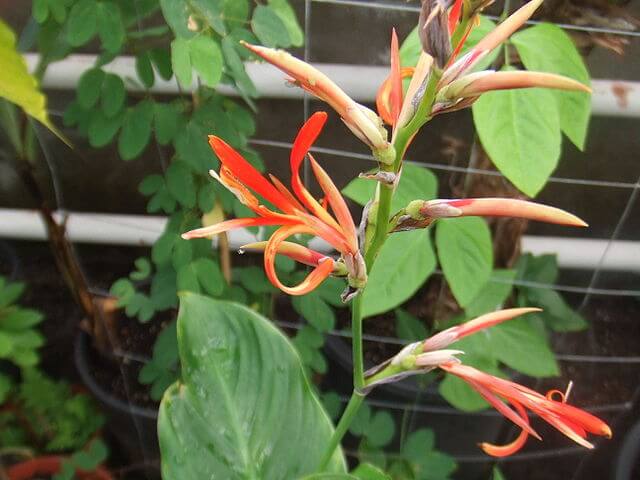

2.2 Growing cannes - temperature
This thermophilic plant can be kept during the growing season and budding. at normal room temperature... Indoor Cannes feel great in the summer heat.
In general, the growth rate in this case will strongly depend on the temperature of the content - the higher it is, the faster the plant develops.
↑ Up,
During flowering the temperature can be lowered slightly to 18 — 20° Cto extend it. During the dormant period, the tubers are stored in a cool place with a temperature 7 - 12 ° C.
Plants do not like a sharp change in temperature regime - for example, a cold snap can lead to a slowdown in development and the cessation of bud formation.
The flower can withstand short-term frosts, but you should not expose it to these tests.
↑ Up,


2.3. Reproduction, cannes from seeds
Cannu is often bred daeration of the rhizomes of adult plants. This method is carried out in the spring - in March.
- Rhizomes are cleaned of old soil and cut into several parts with a sharp sterile knife or pruner.
- The wound surface resulting from such a division is treated with finely ground charcoal powder.
- As a result of division, each part should receive its own growth buds, a fairly well-developed root system.
- The plots are planted in a plastic container, positioned very close to each other so that the renewal buds are horizontally in the substrate.
- When planting, the ground around the plant should be tamped a little so that no air pockets remain.
- From above, such delenki are sprinkled with simple river sand and watered with well-settled water at room temperature.
- The top of the container is covered with a transparent plastic lid or glass to maintain an evenly high level of humidity and create a greenhouse effect.
- Plants should germinate in a warm place at a temperature of 22 - 25 ° C, the use of bottom heating will increase the chances of germination.
- With the appearance of the first signs of development, the rhizomes are dug out of the ground and transplanted into separate pots.
- Seedlings are hardened by placing them in a cool place with a temperature of 15 - 17 ° C.
- When each plant forms a sufficient green mass, cannes can be taken out into the street and accustomed to new conditions of existence.
↑ Up,
Small children often appear around the rhizomes of adult plants - small daughter rhizomes, which are also separated and planted.
It is also possible to grow canna from seedhowever, germination occurs over a long period of time.
The planting material is large and covered with a black, very dense shell, therefore, it will need pre-sowing treatment for germination. Seeds scalded boiling water, which will help soften this shell. After scalding, the seeds are placed in a thermo mug or thermos along with warm water and kept so for several more hours.
Interestingly, instead of scalding, you can also use to increase germination cold or warm stratification - with this method of preparation, the seeds are kept either on a strong heat source for 10 - 12 hours, or in the vegetable compartment of the refrigerator for a couple of hours.
Good results are obtained scarification - deliberate damage to the outer shell of the seed with files or emery paper.
↑ Up,
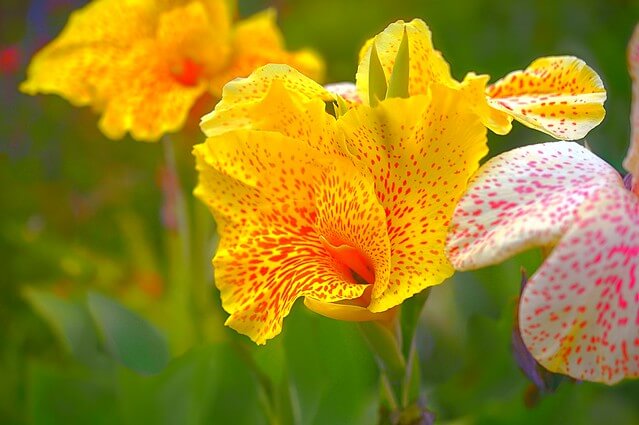

Sowing spend at the end of winter - in February.
- For planting, take a plastic container with drainage holes and a lid.
- A drainage 1 - 2 cm high is placed at the bottom of the container.
- Fill the container with a nutritious, loose substrate.
- The soil in the container is moistened with a fine spray with water at room temperature.
- The seeds are sown, covering them on top with a substrate about 1 cm thick. From above, the crops are also sprayed with water at room temperature.
- Seedlings should be placed in a warm room with a temperature of 23 - 25 ° C.
- The location should be brightly lit, but out of direct sunlight.
The first signs of growth can be seen within 3-4 weeks... All this time, the substrate in containers and cups is kept evenly moist.
Plants if necessary dive - they are seated in their own pots with the appearance of 3 - 4 leaves.
You can plant in small separate cups and then, with the appearance of the first true leaves, there will be no need to dive the plants into different containers from a common container.
↑ Up,
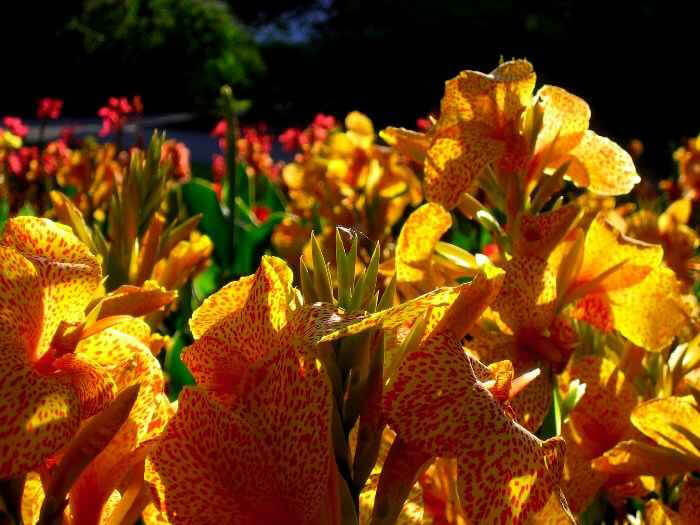

The first top dressing small bushes are carried out when 10 - 14 days have passed from the moment of the pick. For feeding, a mineral fertilizer for flowering plants highly diluted with water is used.
Remember that seed-derived plants may not inherit all the varietal appeal of the parent.
The strongest and larger bushes obtained from seeds can bloom during the first year of life, but the bulk of the bushes will form buds the next year.
In order for young plants not to waste their energy on the formation of buds, but to become the owners of a powerful root system, it is recommended to remove the first peduncles that appear.
For flowering in the current season, canna seeds must be sown in January, and young plants must develop with good artificial lighting.
Germination of seeds can be carried out not only in the soil, but also in simple wet gauze or between wet cotton pads moistened with water.
↑ Up,
2.4 Transplant
Plants prefer spacious potsso repot them before the container gets cramped.
Since many varieties of cannes are impressive in size and can tip over under their own weight, it is necessary to plant them stable containers.
↑ Up,


Planting rhizomes in a fresh substrate and a new pot is carried out in the spring, with the first signs of growth at the rhizomes or even before it.
- Pick up a pot for planting with large drainage holes.
- A good drainage layer of expanded clay or river pebbles is poured into the pot.
- On top of the drainage layer, sprinkle with nutritious soil and place the rhizome of the plant in the center of the pot.
- Sprinkle the flower with earth in such a way that a distance of 1 - 2 cm remains to the upper edge of the pot.
- After planting, the substrate is lightly rammed and the plant is spilled.
Small shoots will appear above the surface of the soil within 20 days after planting.
Re-watering should be done in moderation, often only when the first shoots appear above the soil surface.
Transplanted plants should not be exposed to direct sunlight - this will only add stress to them.
Feeding such flowers can be postponed for 2 - 3 weeks, since there are already enough nutrients in the fresh soil.
↑ Up,
You may also be interested in:
- Astilba - photo, planting and care in the open field, description of the flower, varieties and types of plants, use in landscape design, growing at home, flowering time, height, soil selection
- Strelitzia royal or bird of paradise - a photo of a flower, home care, reproduction - growing from seeds, the composition of the soil for keeping in a pot, why the houseplant does not bloom
- Freesia - photo of a flower, planting and care in the open field, growing homemade freesia in a pot, description of the plant, flowering, planting bulbs, varieties
- Royal begonia - photo, home care, planting, growing in the open field and in a pot, plant flowering, reproduction, soil
↑ Up,


2.5 Flowering time
June - October... Flowers open sequentially and on one peduncle can remain open for several weeks.
Each bush can remain in bloom for 2 months and form 3 - 4 peduncles.
When grown outdoors, flowering can be interrupted only with the onset of frost.
Cannu can be used on distillation and get peduncles with proper care and sufficient lighting by the desired date. When forcing, rhizomes are planted in the ground 6 to 8 weeks before the desired onset of flowering.
↑ Up,
2.6 Soil
Well-drained, nutrient-rich, loose soil with a high organic content... Cannes can grow in almost any soil with good nutrition and moisture.
The mixture for maintenance can be made on the basis of leaf and sod land, peat and humus with the addition of perlite or coarse river sand to improve drainage.
Mixing a small amount of charcoal into the ground can add nutrients and decontaminate the soil.
The planting substrate must have a neutral pH within 6.5 to 7.5.
↑ Up,
2.7 Watering
The plant requires regular watering during the period of active growth. In winter, the tubers are kept almost completely dry.
The first watering is carried out after planting in the ground and they should be moderate, since the plants have not yet formed large leaves that evaporate a sufficient amount of water.
As it grows, the volume of water for irrigation increases.
Before the onset of flowering, the canna is watered abundantly - until the soil is completely soaked, but the excess moisture that appears in the pan after watering must be drained.
After the flowers wither, the frequency of watering and the amount of water are gradually reduced again.
As the ground green part dies off, the soil is dried more and more - as a result, the rhizomes should remain in a practically dry substrate.
Watering is possible only warm and good defended tap water. Young bushes need careful and regular watering, while adult plants can tolerate short-term drought.
↑ Up,


2.8 Top dressing cannes
Potted plants have a very limited nutritional area and need additional nutrients to the soil. Canna reacts extremely positively to fertilizers and rewards flower growers with lush flowering.
With the beginning of new growth, they are fed with complex liquid fertilizers for flowering plants every week.
Fertilizers for canna should contain sufficient amounts of phosphorus, potassium and nitrogen.
During the rest period, feeding is stopped. In the spring, fertilization begins again with the appearance of the first signs of new growth.
It is advisable to fertilize with a weak solution, diluting mineral fertilizers to half the dose recommended on the package.
Fertilizers are applied only after abundant watering, into moist soil.If too concentrated a solution gets on the roots of plants in dry soil, it can cause a chemical burn.
↑ Up,
2.9 Diseases and pests
Plants that are well cared for rarely suffer from pests and diseases.
- Tubers can rot with waterlogging of the soil and stagnant water - while the flowers and buds will blacken and die off. When the first signs of decay appear, the rhizomes are taken out of the ground, inspected and removed all areas affected by rot, cutting them to healthy tissues. Places of cuts are treated with brilliant green or iodine, sprinkled with charcoal powder. Planting such plants is carried out only in fresh soil, since pathogens can remain in the old one. After planting, watering is suspended for several days, allowing the root system to heal the wounds.
- Fungal diseases can cause gray rot, plants can be affected rust, sheet spotted and mosaics.
- Sometimes appears bacteriosis.
- Canna does not bloom in too cramped pots, where rhizomes have nowhere to develop, when kept in too cool conditions, in the absence of a dormant period and insufficient lighting.
↑ Up,
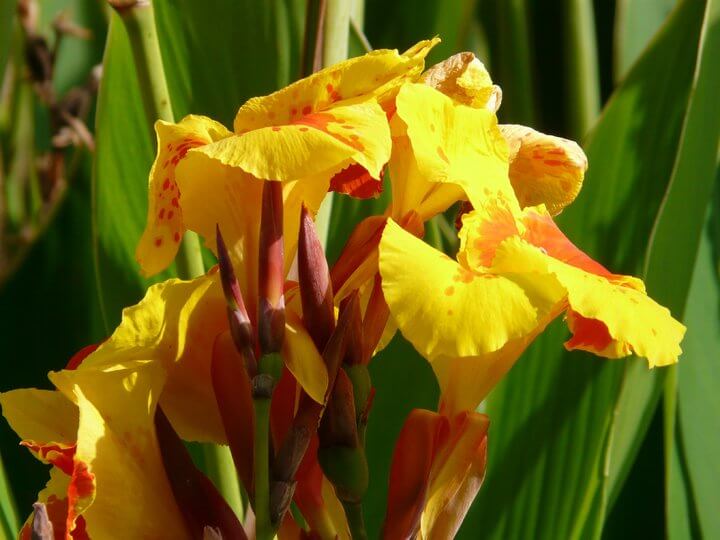

Of the harmful insects the plant is to the taste of nematodes, scale insects, aphids, spider mites. When grown outdoors, the flower can be attacked by slugs and snails, caterpillars of various butterflies, wireworms.
Insects are pests
| Insect name | Signs of infection | Control measures |
| Nematodes | The leaf blades turn yellow in places located between the veins, then turn brown, black. Eventually, the leaves fall off the plants. When the root system is damaged, the plant becomes weak and withers before our eyes for no apparent reason. | Traditional methods: destruction of infected parts of plants, abundant watering with hot water at a temperature of about 70 ° C, hot bath - immersion of the pot in a large container with water at a temperature of 55 ° C for 20 minutes. Chemicals: anthelmintic agents. |
| Spider mite | Subtle spider webs on the leaves, yellowing and foliage falling off with extensive lesions. The surface of the sheet plates becomes dead and covered with small cracks. Plant development slows down. | Folk ways... Plants can be rinsed in the shower and left in the bathroom in a humid atmosphere for half an hour. Irradiation with an ultraviolet lamp every week for 2 minutes. Chemicals based on pyrethrum, sulfur powders, Fitoverm, Actellik. |
| Aphid | Sticky droplets appear on the leaf plates, the leaf plates curl up and deform, delicate buds and young leaves wither. Colonies of insects can be seen on the tops of the shoots, on the buds or on the underside of the leaf plates. The flowers of aphid-infested plants may become deformed. | Folk ways: infusion of nettle, decoction of rhubarb leaves, wormwood, soap solution, infusion of tobacco and dandelion, onions, marigolds, yarrow, tansy, dusting with ash. Chemicals: Sulfur powders, treatment with green potash soap of green mass without getting into the ground, Decis, Aktellik, Fitoverm. |
| Shield and false shield | Sticky droplets on the leaves, small yellow spots on the surface of the leaf plates. With a large spread of scale insects, they contribute to the drying and falling of leaves. Flowers slow down their development | Folk methods of struggle... Spraying with soap and alcohol solution. Scabbard larvae do not like garlic infusion; they also use pyrethrum-based products. Chemicals... Fitoverm, Aktellik, Fufanon. |
| Caterpillars | Through holes in leaf blades, skeletonized leaves, gnawed edges of leaves, spider webs and cocoons on leaves. | Mechanical control measures: collection and destruction by hand, the device of trapping belts and the installation of pheromone traps. Folk ways: spraying with a decoction of yarrow, potato tops, infusions of tobacco, wormwood and garlic, fumigation with smoke. Chemical and biological agents: biological agents - Fitoverm, Entobacterin, insecticidal preparations - Actellik, Iskra, Aktara, Karate, Inta - Vir, Fufanon, Karbofos. |
| Snails, slugs | Through holes in leaf blades, traces of mucus on the surface of the leaves. | Folk ways: manual collection of harmful insects, dusting plant leaves with mustard and hot pepper, wood ash mixed with baking soda, tobacco dust. Chemicals: superphosphate granules, copper preparations, Thunderstorm, Slime-eater, Antislice, Meta. |
| Wireworm | Plants slow down development and wither for no apparent reason. | Folk ways of getting rid: infusion of celandine, dusting seeds with wood ash, sprinkling with lime or dusting with dolomite flour, onion husks. Chemicals: drugs Pochin, Actellik, Decis. |
↑ Upward,
2.10 Containment Procedures, Cropping
In general, the plant is relatively unpretentious, resistant to various diseases and forgives some mistakes in care, however, this flower also requires adherence to certain agricultural techniques.
If possible, take out the canna to fresh air at the beginning of summer. Place the flower in a place out of direct sunlight, and protected from strong gusts of wind and rain.
Remove peduncles with wilting flowers - this will extend the flowering period and maintain the neat appearance of the plant. After flowering, the leaves turn yellow and then turn black - at this time, all aerial parts of the plant should be removed. Do not cut off the slightly yellow leaves - they continue to provide the plant's rhizome with nutrients.
Provide tall flower stalks support, as they sometimes do not withstand the weight of the flowers and break off.
↑ Upward,
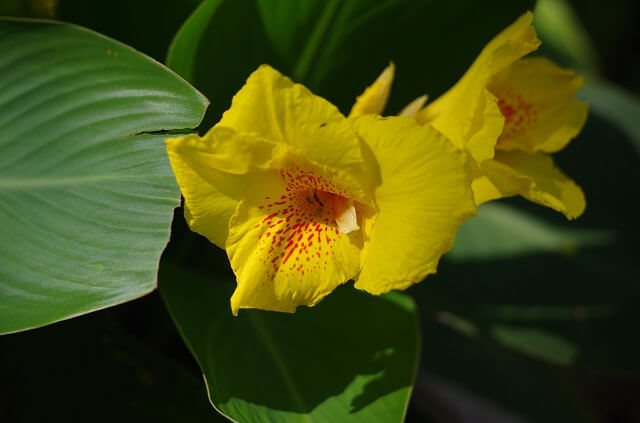

In winter, store canna tubers in a mixture of peat and sand so that they do not come into contact with each other. When the peat dries up, moisten it a little. Place the tuber container in a cool, dark place.
The dormant period of these flowers is short and lasts only a couple of months, after which growth begins anew.
Since canna tubers can be used for distillation, it is worth monitoring the soil temperature during the winter months.
If the plant is on a too cool windowsill, then its root system will suffer from severe cold and a sheet of insulation should be spread under the flower pot.
Occasionally wipe large leaves of the plant from dust with a damp sponge.
↑ Upward,
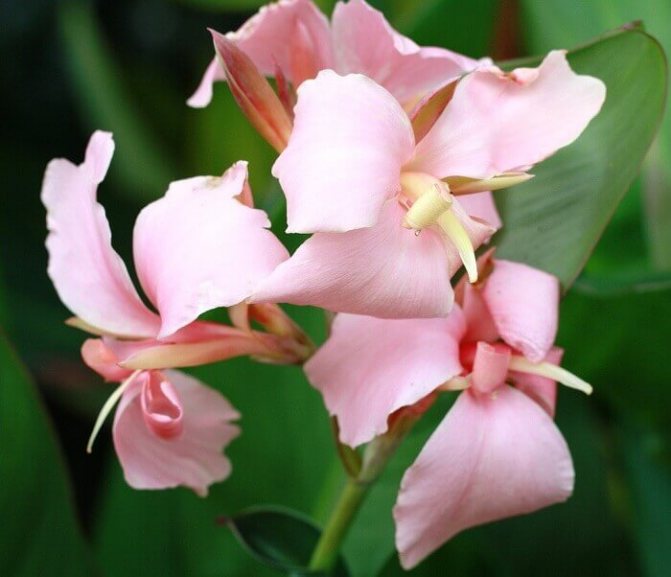

2.11 Lighting
The plant will bloom profusely only when bright lighting and direct sunlight for 6 hours every day. Flowers can take sun baths in the morning and evening hours. In too hot spring and summer daytime hours, it is still better to shade the cannu with a light tulle curtain.
If there is a lack of natural light in autumn and winter, illumination with fluorescent or phytolamps is possible.
When grown in partial shade, the stems of the plant stretch out, and the leaves turn pale, the canna does not bloom.
Window sills are most suitable for growing. southwestern, southeast windows... Growing on the north side it is impossible without additional lighting.
↑ Upward,
You may also be interested in:
- Fragrant geranium - photo, medicinal properties, home care, description of varieties of indoor plants, propagation by cuttings - rooting, flowering time, use of essential oil, pruning, transplanting
- Ficus - photo, home care, names and photos of varieties, reproduction, signs, transplanting indoor plants, watering, pruning and shaping
- Poultry garden - photo, planting and care in the open field, description of the plant, medicinal properties, home care, application. flowering time, varieties and species, potting soil, transplanting
- Cyclamen - home care, photos, maintenance after purchase, reproduction - growing from seeds, flowering, transplanting, soil for growing in a pot
- Lily - a photo of a flower, planting and care in the open field and at home, reproduction, pruning and transplanting of domestic lilies, the composition of the soil for growing, feeding
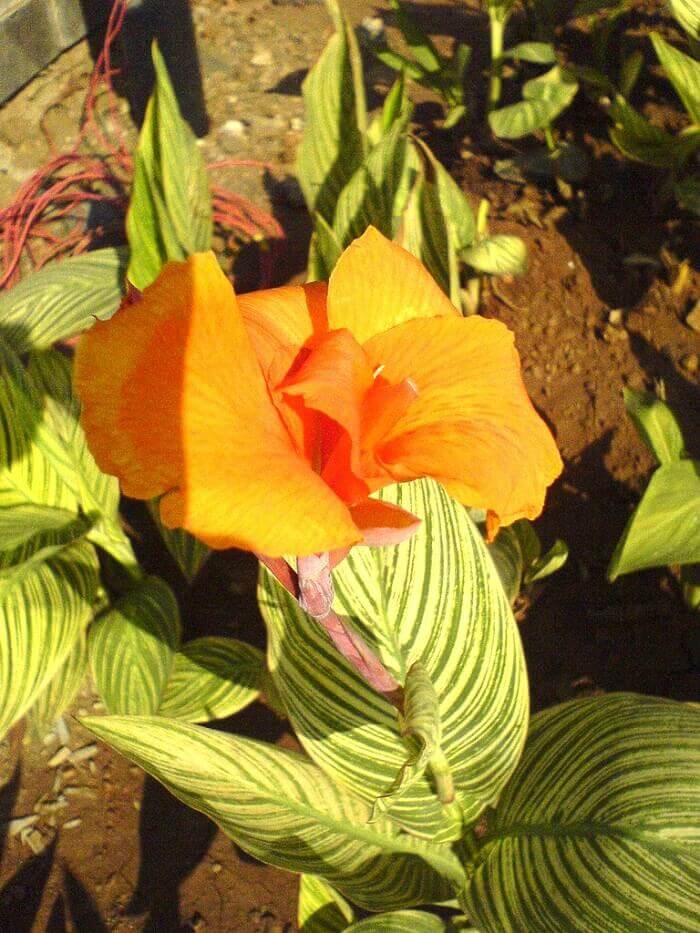

2.12 Spraying
Spray plants in the morning, once or twice a day warm water, being careful not to get on the buds and flowers. The moisture must have time to evaporate before dark, otherwise rot may occur.
Provide the plant good air movementavoiding cold drafts.
Avoid placing the cannabis pot near heat sources during the fall and winter months, and do not place the plant pot under an air conditioner in the summer.
↑ Upward,
2.13 Intended use
When grown at home, cannes can be used both as decorative deciduousas well as in quality flowering plants... Currently, varieties with brightly colored striped or burgundy leaf blades have been bred.
For 9-10 months a year, these plants look great and can beautify any interior.
In landscape design this flower will also not go unnoticed and will become a bright accent on any flower bed or flower garden.
Cannes flowers can be used when drawing up bouquets and for cutting


